Best Tourism Degrees

Are you ready to discover your college program?
“ By some measures, tourism may already be the world’s largest industry, with annual revenue approaching $500 billion. ” – peopleandplanet.net
A hospitality management degree online program provides students the business skills and cultural education necessary to run travel agencies, organize cultural attractions, operate a food service business, plan meetings as well as large conventions and events, facilitate operations at hotels, theme parks, casinos and resorts, promote tourism, and arrange individual, group, or corporate trips and tours around the world.
A hospitality management online degree allows students to work in sectors such as food service operations, visitor bureaus and conventions, recreational business, tourism development agencies, hotels, resorts, theme parks, international travel and tourism agencies, airlines, and casinos. In fact, the Bureau of Labor Statistics forecasts a 8% employment growth for hotel meeting planners from 2022 to 2032, and a average salary of $52,560 a year.
Hospitality management online degree programs vary widely across the universities and colleges. Tourism and hospitality degree programs offer bachelor and master degrees in many different concentrations and specializations, such as tourism, hospitality, travel, recreation, and event/meeting management.
Programs in the field offer courses such as tourism and hospitality marketing, food service management, brand management, travel law, international travel, hospitality and tourism management, sustainability in hospitality and tourism, operational management, corporate finance, and economics of travel and tourism.


Best Tourism Degree
Tourism degree programs ranking guidelines.
We ranked these degree programs based on quality, curricula, school awards, rankings, and reputation.
Featured Schools
The schools are listed in alphabetical order. The list includes mainly bachelor degree programs and a few master degree programs.
The Best Tourism Degree Programs
Arizona state university-downtown phoenix.
- Campus + Online
- In-State $10,710
- Out-of-state $28,800
- Retention Rate 85%
- Acceptance Rate 82%
- Students Enrolled 11,420
- Institution Type Public
- Percent Online Enrollment 57%
- Accreditation Yes
Brigham Young University-Hawaii
- In-State $5,720
- Out-of-state $5,720
- Retention Rate 61%
- Acceptance Rate 97%
- Students Enrolled 3,096
- Institution Type Private
- Percent Online Enrollment 21%
Florida International University
- In-State $4,721
- Out-of-state $16,529
- Retention Rate 89%
- Acceptance Rate 58%
- Students Enrolled 58,711
- Percent Online Enrollment 68%
George Mason University
- In-State $9,060
- Out-of-state $32,520
- Retention Rate 86%
- Acceptance Rate 87%
- Students Enrolled 37,863
- Percent Online Enrollment 33%
Indiana University-Bloomington
- In-State $9,575
- Out-of-state $35,140
- Retention Rate 90%
- Acceptance Rate 78%
- Students Enrolled 43,260
- Percent Online Enrollment 19%
Johnson & Wales University-Online
- In-State $13,365
- Out-of-state $13,365
- Retention Rate 25%
- Acceptance Rate 41%
- Students Enrolled 1,752
- Percent Online Enrollment 0%
New York University
- In-State $50,684
- Out-of-state $50,684
- Retention Rate 94%
- Acceptance Rate 16%
- Students Enrolled 52,885
- Percent Online Enrollment 10%
Purdue University-Main Campus
- In-State $9,208
- Out-of-state $28,010
- Retention Rate 91%
- Acceptance Rate 60%
- Students Enrolled 45,500
- Percent Online Enrollment 22%
Rochester Institute of Technology
- In-State $44,049
- Out-of-state $44,049
- Retention Rate 88%
- Acceptance Rate 71%
- Students Enrolled 16,254
- Percent Online Enrollment 18%
Temple University
- In-State $16,080
- Out-of-state $28,992
- Students Enrolled 38,794
Texas A&M University-College Station
- In-State $7,941
- Out-of-state $34,190
- Retention Rate 93%
- Students Enrolled 68,726
- Percent Online Enrollment 14%
University of Hawaii-West Oahu
- In-State $7,344
- Out-of-state $20,304
- Retention Rate 76%
- Acceptance Rate 84%
- Students Enrolled 3,049
- Percent Online Enrollment 71%
University of Massachusetts-Amherst
- In-State $15,791
- Out-of-state $35,112
- Acceptance Rate 64%
- Students Enrolled 31,350
- Percent Online Enrollment 15%
University of New Hampshire-Main Campus
- In-State $15,520
- Out-of-state $32,050
- Students Enrolled 14,788
- Percent Online Enrollment 16%
University of Southern Maine
- In-State $7,868
- Out-of-state $20,692
- Retention Rate 69%
- Acceptance Rate 81%
- Students Enrolled 8,429
- Percent Online Enrollment 40%

Best Online Colleges of 2024
Online college has made accessible education a reality for many. Discover what online colleges do best and what programs you can choose from.

Best Accelerated Online Bachelor’s Degrees

Best Online Colleges to Start Anytime
Take the next step toward your future with online learning.
Discover schools with the programs and courses you’re interested in, and start learning today.

Browse Econ Literature
- Working papers
- Software components
- Book chapters
- JEL classification
More features
- Subscribe to new research
RePEc Biblio
Author registration.
- Economics Virtual Seminar Calendar NEW!

Approaches to Active Tourism in the Urals and in Perm Krai
- Author & abstract
- Related works & more
Corrections
- Ziryanov Aleksander I.
- Korolev Andriej Y.
- Mishlavtceva Swietlana E.
(Perm State University, Perm (Russian Federation))
Suggested Citation
Download full text from publisher.
Follow serials, authors, keywords & more
Public profiles for Economics researchers
Various research rankings in Economics
RePEc Genealogy
Who was a student of whom, using RePEc
Curated articles & papers on economics topics
Upload your paper to be listed on RePEc and IDEAS
New papers by email
Subscribe to new additions to RePEc
EconAcademics
Blog aggregator for economics research
Cases of plagiarism in Economics
About RePEc
Initiative for open bibliographies in Economics
News about RePEc
Questions about IDEAS and RePEc
RePEc volunteers
Participating archives
Publishers indexing in RePEc
Privacy statement
Found an error or omission?
Opportunities to help RePEc
Get papers listed
Have your research listed on RePEc
Open a RePEc archive
Have your institution's/publisher's output listed on RePEc
Get RePEc data
Use data assembled by RePEc


Best Travel and Tourism colleges in California

Top schools offering Travel and Tourism degrees in California
Travel and tourism.
- Tourism and Travel Services Marketing Operations Schools
List of all Travel and Tourism colleges in California
- Skip to main content

- All countries /
- North America /
- Travel and Hospitality /
- Travel and Tourism
159 Universities in the USA offering Travel and Tourism degrees and courses
More Information
Are you looking for Travel and Tourism courses? Here you can find course providers offering full-time, part-time, online or distance learning options.
You've reached your limit of 10 Favourites
Fairleigh Dickinson University, Vancouver Campus
New york university - school of professional studies, central connecticut state university.

California State University Northridge
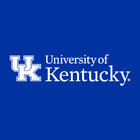
University of Kentucky
THE World Ranking: 401
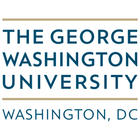
George Washington University
THE World Ranking: 201

Oklahoma State University - Stillwater
THE World Ranking: 601

Johnson and Wales University - Providence
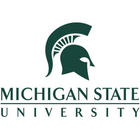
Michigan State University
THE World Ranking: 116

Orange Coast College

Colorado State University
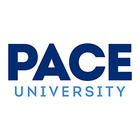
Pace University
- Tour Operation (Abroad)
- Tourism / Travel
- Tourism Development / Promotion
- Tourism Management
- Travel Studies
- Alabama (inc. Montgomery)
- Alaska (inc. Juneau)
- Arizona (inc. Phoenix)
- California (inc. Sacramento)
- Colorado (inc. Denver)
- Connecticut (inc. Hartford)
- Delaware (inc. Dover)
- Washington, D.C.
- Florida (inc. Tallahassee)
- Georgia (inc. Atlanta)
- Hawaii (inc. Honolulu)
- Idaho (inc. Boise)
- Illinois (inc. Springfield)
- Indiana (inc. Indianapolis)
- Iowa (inc. Des Moines)
- Kansas (inc. Topeka)
- Kentucky (inc. Frankfort)
- Louisiana (inc. Baton Rouge)
- Maine (inc. Augusta)
- Maryland (inc. Annapolis)
- Massachusetts (inc. Boston)
- Michigan (inc. Lansing)
- Minnesota (inc. St. Paul)
- Mississippi (inc. Jackson)
- Missouri (inc.Jefferson City)
- Montana (inc. Helena)
- Nebraska (inc. Lincoln)
- Nevada (inc. Carson City)
- New Hampshire (inc. Concord)
- New Jersey (inc. Trenton)
- New Mexico (inc. Santa Fe)
- New York (inc. Albany)
- North Carolina (inc. Raleigh)
- North Dakota (inc. Bismarck)
- Ohio (inc. Columbus)
- Oklahoma (inc. Oklahoma City)
- Oregon (inc. Salem)
- Pennsylvania (inc. Harrisburg)
- Rhode Island (inc. Providence)
- South Carolina (inc. Columbia)
- Tennessee (inc. Nashville)
- Texas (inc. Austin)
- Utah (inc. Salt Lake City)
- Vermont (inc. Montpelier)
- Virginia (inc. Richmond)
- Washington (inc. Olympia)
- West Virginia (inc. Charleston)
- Wisconsin (inc. Madison)
- Wyoming (inc. Cheyenne)
- Study level:
- All study levels
- Postgraduate
- Undergraduate
- Career based/Vocational
- Study mode:
- Online/Distance
- Cross-border
Filter your results
Tell us about you.
- Nationality Select country Select country
- My current qualification is from Select country Yes No Select country Select country
- Current qualification {0} is not applicable for the study level you selected below. Qualification Qualification
- Grade type (only one grade type for your qualification) Grade type Grade type
- My score (current or expected) Please select Please select Please select Please select Please select Please select
Tell us your preferences
- Subject Travel and Tourism
Qualification
- Destination USA
- Study options
- Annual tuition fees
Subject areas
Destination.
- The UConn School of Business has grown to become one of the most comprehensive business schools in the country.
- NEW: Want to study in your home country for a foreign qualification? Find out more about cross-border study!

Share ×

Scan the QR code and open PeakVisor on your phone
❤ Wishlist ×
See all region register, peakvisor app.
The Perm Territory lies in the north-eastern part of the East-European Plain and on the western slopes of the Middle and North Urals in Russia . It is situated at the junction of Europe and Asia with 98% of the territory being in Europe and only 2% belonging to Asia.

Flora and Fauna
Water resources, landmarks and tourism, the basegi ridge, kolpaki mountain, mount oslyanka, ski and sports facilities, the divya cave, the kungur cave, the orda (ordinskaya) cave, the miracle cave, protected sites (reserves, national and natural parks), water resources, the vizhay river, the vilva river, the koiva river, the usva river, alexandrovsk blue lakes, the white sea in berezniki, zoo nurseries, major cities.
In the distant past, this territory was called Perm the Great. The name came from the word ‘Permaa’, which meant ‘a distant land’. The capital of Perm the Great was Cherdyn which was considered the oldest city of the Kama Region. The first province was formed in 1792 and in 2005, two big regions merged to form a huge federal land called the Perm Territory. In spite of the fact that it is geographically closely connected with the Urals when the Russian federal districts were created in the 2000s, the Perm Territory was administratively assigned to the Volga Region thus becoming a part of the Volga Federal District. Its administrative centre is the city of Perm.
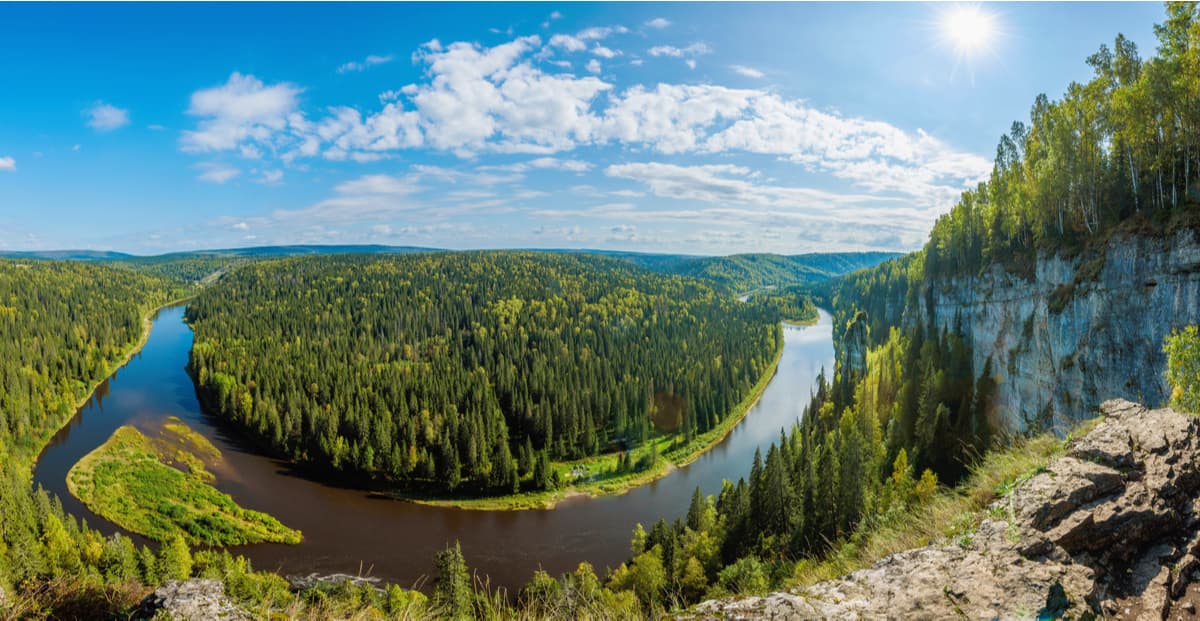
The borders of the region follow the natural terrain and are very erratic. The Perm Territory borders the Komi Republic in the north, the Sverdlovsk Region in the east, Bashkiria in the south, the Kirov Region and Udmurtia in the west.
Its territory is 160,237 sq.km., from north to south the region stretches for 645 km, from west to east – 420 km, the population is 2 599 301 people (as of 2020), most of them live in the 22 cities.
The main feature is the Ural Mountains . The western and central parts of the Territory are dominated by low and flat terrain, while in the east start large hills and lowland mountainous terrain. In the west of the plain part, there is the Verkhnekamsk Upland (with heights up to 335 m) and the Okhansk Upland continuing in the centre of the region. In the north-west, there are loosely separated hills of the Northern Urals (up to 270 m high). In the south rises the Tulva Upland (up to 446 m high) and in the south-east, there is the Sylva Ridge at the edge of the Ufa Plateau (up to 403 m high).
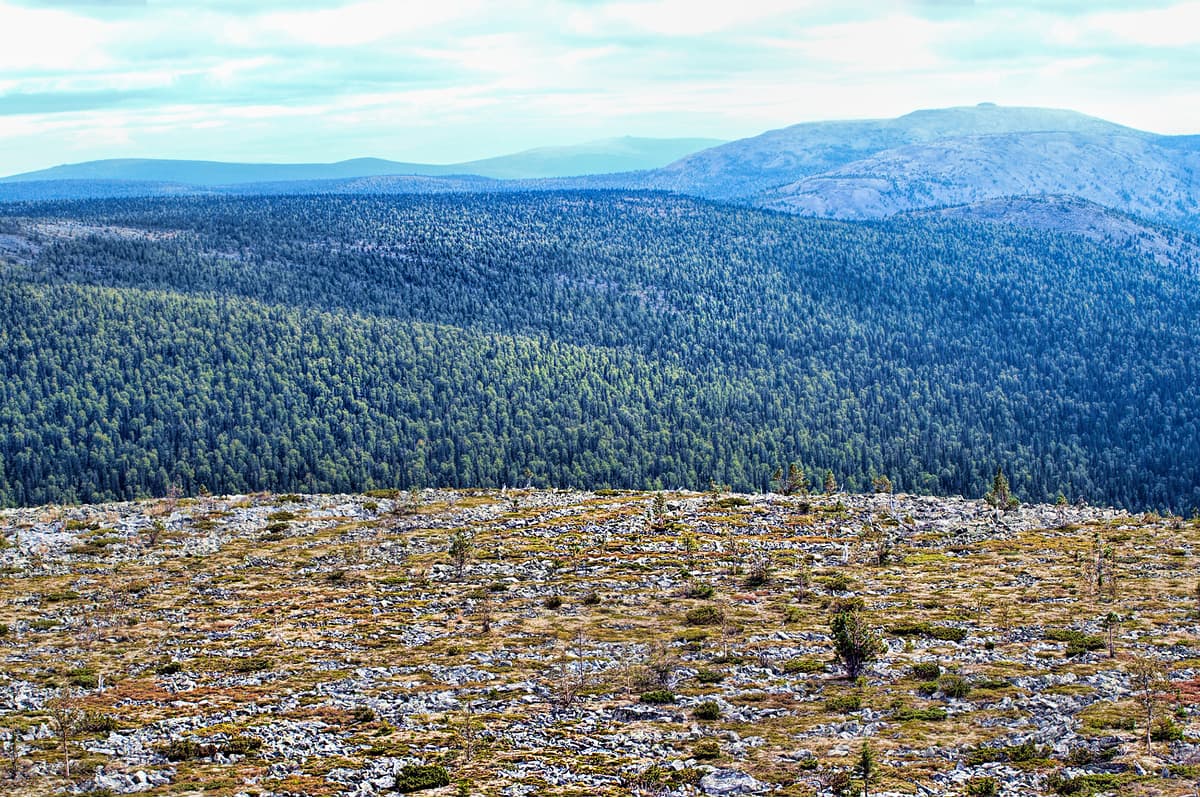
The Perm Territory is rich in karst phenomena, especially in the south-east. The highest mountains are situated in the north (the Northern Urals), there is Tulymsky Stone (1,469.8 m, the highest peak of the Perm Territory), Isherim (1,331 m), HuSoik (1,350 m), Molebny aka Prayer Stone (1,240 m), Martai (1,132 m). The usual name for mountains in the Urals is ‘stones’, they tower over the rest of the area. Among the mountains of the Middle Urals , the highest are located in the Basegi Range (993 m).
Over two-thirds of the territory is occupied by forests mainly represented by dark coniferous taiga. There are two subzones: the middle and the southern taiga. The forests in these zones differ. The middle taiga is dominated by conifers, predominantly by spruce and fir. There are two types of spruce in the territory of the region: the European and the Siberian spruce. The southern taiga features broad-leaved tree species, e.g. linden, maple, elm. Among other tree species, you can find cedar (or rather cedar pine), juniper, three species of birch (silver, downy, and drooping or nodding birch), ground cherry, bird cherry, mountain ash, and aspen. More than 60 plant species are included in the Red Book of the Perm Territory. There are a lot of endemic and relict species, most of them can be found in the many reserves located in the Perm Territory.
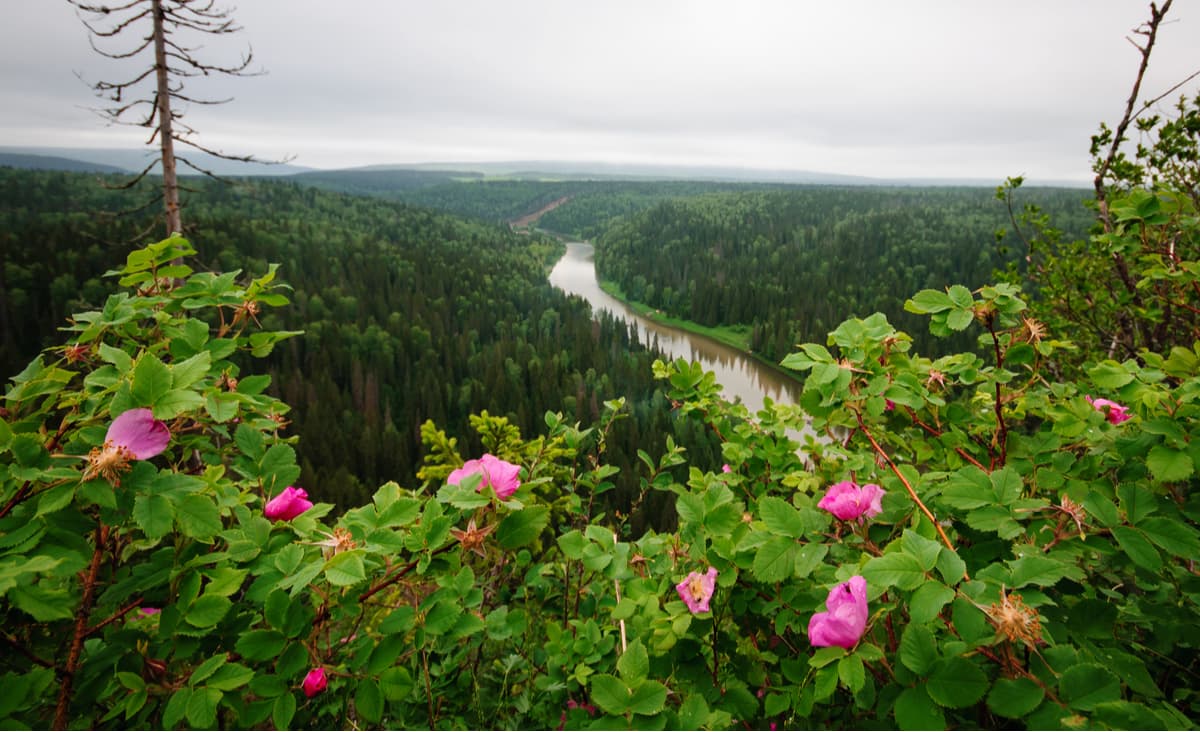
The animal world is astounding, there are 62 mammal species, 270 bird species, 42 fish species, 6 reptiles, and 9 amphibians. The most common predator is forest marten. By the number of martens, this region occupies one of the first places in Russia. There are ermine, weasel, badger, otter, wolverine living peacefully in the local forests. Bears and lynx can be found all over the territory, except the very south, but their numbers are small. Wolves and elks can also be spotted occasionally. When winters are not very snowy, roe deer can come to the eastern parts of the region from the neighbouring Sverdlovsk Region . And in the northern regions, there come deer from the Komi Republic . Hunting some animals (sable, otter, marten, moose) is possible only under special permits (licenses). Roe deer and reindeer are under protection and hunting them is prohibited.
The river network is the densest in the country, there are 29,179 named rivers. The region ranks first in Russia in terms of the rivers’ length and water capacity. The largest rivers of the region are the Kama with its tributaries of the first and second-order: the Vishera, the Chusovaya, the Kosa (Kama tributaries), the Kolva (the Vishera tributary), the Sylva (the Chusovaya tributary) and others.
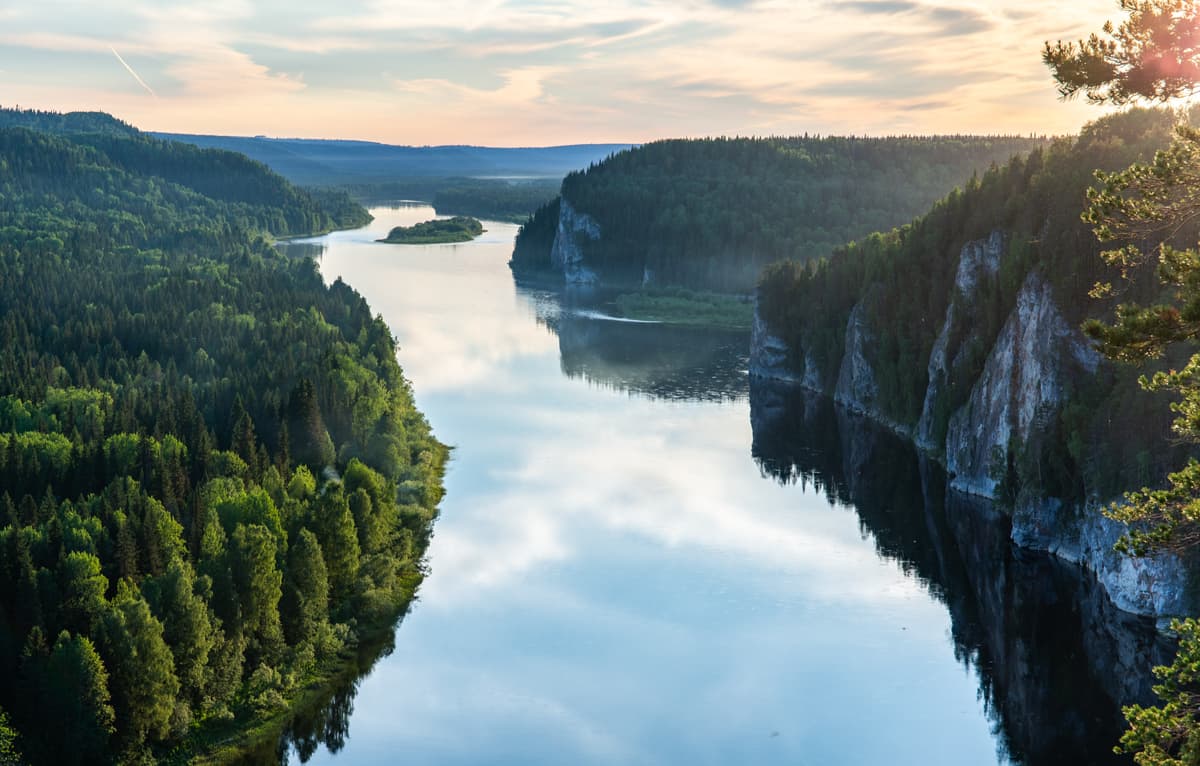
The rivers originate in the Urals. In their upper reaches, the rivers flow down the valleys between mountain ranges and have quite a measured and slow current. Yet once they approach the foothills, rivers acquire more rapid character, typical of mountain rivers, but not for long. When they reach the plains, the currents quieten down and you can enjoy a perfectly calm boat ride. The rivers are characterised by mixed feeding with a predominance of snowmelt (50-60%). Local rivers have plenty of spring floods when water levels rise dramatically and very rapidly, whereas summer and autumn seasons enjoy low water sometimes interrupted by rainfall floods. Winter is defined by low water as well. Rivers get frozen in the second half of November and open in late April – early May.
As to the lakes, the figure is mind-blowing over 5.8 thousand. Those lakes and artificial reservoirs include about 690 lakes with the area of more than 0.01 sq.km. and a huge number of smaller lakes. Most of them are located in river floodplains, mainly as meander lakes. Among the boggy massifs of the north of the Territory, there are relict lakes, and in the central areas, there are mainly karst lakes. The largest lake in the Perm Territory is Lake Chusovskoye with 18 sq.km of area. The largest reservoirs are the Kama and the Votkinskoye reservoirs on the Kama River, they were created during the construction of the hydroelectric station and the Shirokovskoye reservoir on the Kosva River.
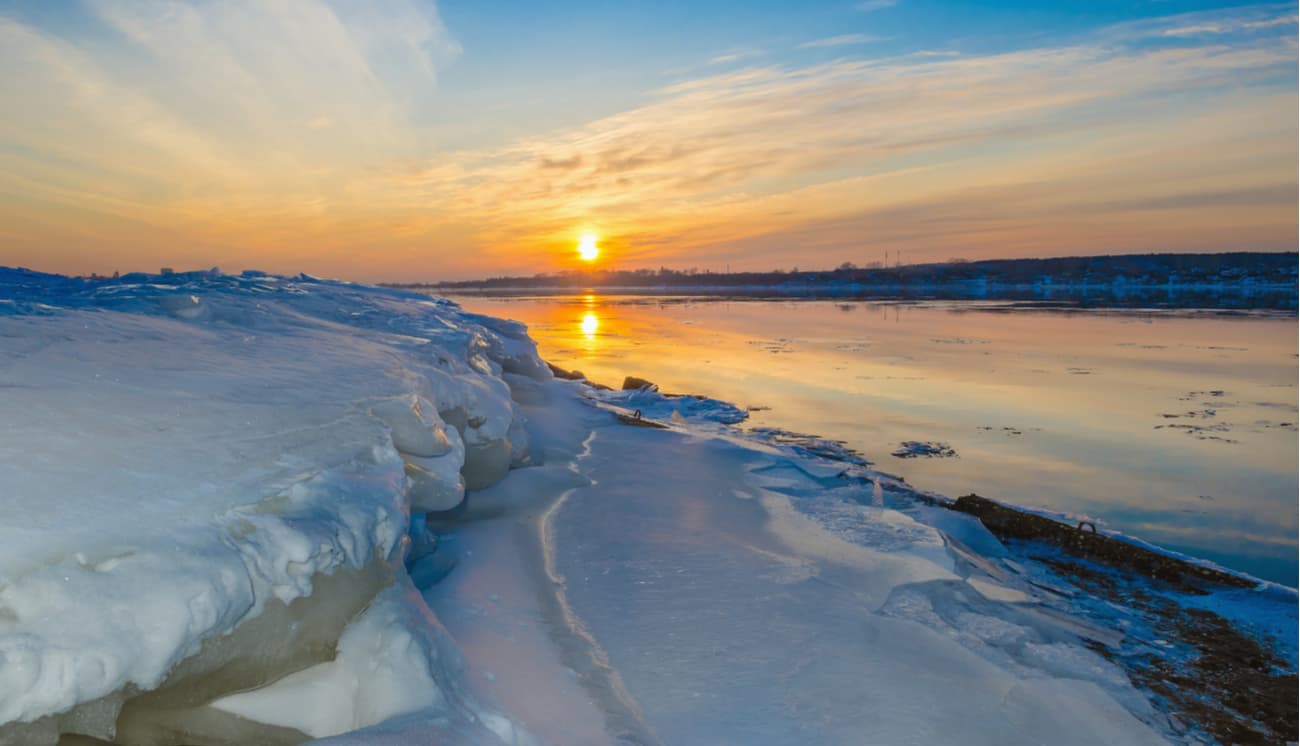
Among the federal regions of Russia, the Perm Territory is second only to Tatarstan in terms of the area of lakes and artificial reservoirs. Swamps and marshlands occupy about 2.31% of the territory which makes it number one in the country if counted by the area of marshes, marshlands and swamps of the territory as a whole. The area and the number of lakes, artificial reservoirs, swamps and marshlands are unstable and depend on natural and anthropogenic factors viz. drainage, watering of territories, etc.
The climate is moderately continental. The Basegi Ridge as well as the Urals Mountains in general are on the way to the western air mass transfer. Thus, despite the relatively low altitude, they significantly limit the spread of air blown in from the Atlantic to the east. As a result, the climate of the Perm Territory has a pronounced continental character. The seasons are distinct, you can surely tell winter from spring and summer from autumn. Winters are long, snowy, and summers are moderately warm. Winter usually starts in November, with snow cover remaining until April and in the north even until May. By March snow thickness reaches about 80-90 cm in the north and 60-70 cm in the south. In the valleys, the snow depth can reach 1.5-2 m, while at the mountain tops it does not exceed 50-70 cm.
The average temperature in January is -17 C (+1 F). There quite often occur severe cold winters with strong winds when the temperature drops to -53 C (-63 F) in the north of the region. Spring comes in early April and brings about unstable weather with extremely sharp fluctuations in temperature. In May, there is a return of cold weather with harsh frosts. The warmest summer month is July. The average temperature of July in the northeast of the region is +15 C (+59 F), and in the southwest, it is +18.5 C (+65 F). On the hottest summer days, maximum temperatures can reach +38 C (+100 F).
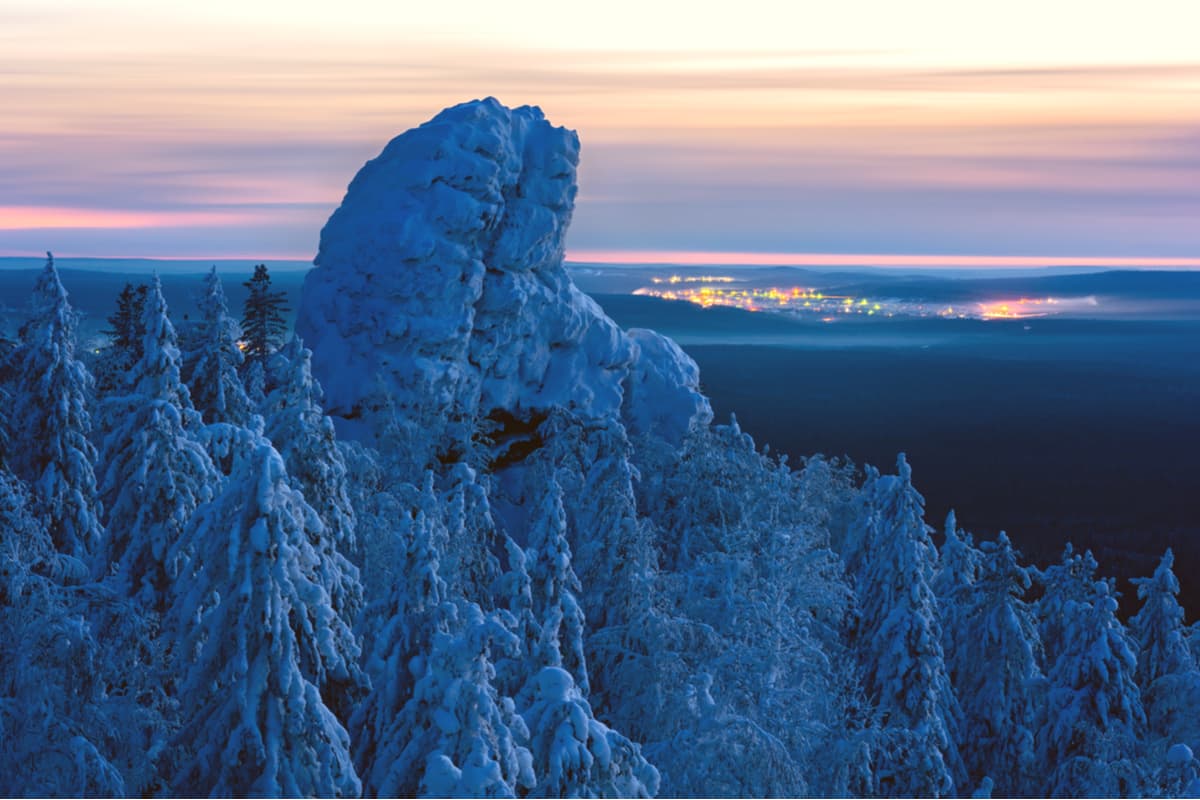
The Perm Territory is blessed with rich deposits of minerals. The world's largest reserves of potassium and magnesium salts, as well as rock salt, are concentrated here. Some time back, this region was called the Salt Capital of Russia. At the end of the 17th century, the city of Solikamsk was the centre of Russian salt production. Currently, salt making in the city has been stopped.
In earlier times, the Kama region massively mined coal. Now all coal mines are closed due to unprofitability. The first Russian diamonds were found in this region as well. The main well-developed industries of the region are oil, chemical and petrochemical, timber, ferrous and non-ferrous metallurgy, machine engineering. As to the chemical industry, mineral fertilizers are dominating the market. The main industrial centres of the Perm Territory are Perm, Berezniki, Solikamsk, Chusovoy, and Lysva. The southern parts of the Territory are agricultural.
The Perm Territory is a major cultural centre. There are many theatres, museums, numerous festivals. At the same time, natural tourism is also developed here due to great natural landmarks. These include beautiful rivers with rocky shores, mountains with wonderful panoramas, and caves with spectacular mazes and grottoes.
The most famous and popular peaks and ranges are the main Ural Mountain Range, the Tulym Range (the Tulymsky Stone), the Chuval Range (the Chuval Stone), the Kvarkush Range, the Basegi Range , the Munin-Tump Mountain, Kruglytsya Mountain, Vetlan Rock and Polyud Rock, Molebny (Prayer) Stone, Kolpaki Mountain, Oslyanka Mountain , Stone City Rocks, Usvinskie Stones and others. Some of these ridges and mountains are located in the reserves of the Perm Territory.
The Main Ural mountain range is the natural border between the Perm Territory and the Sverdlovsk Region , between Europe and Asia.
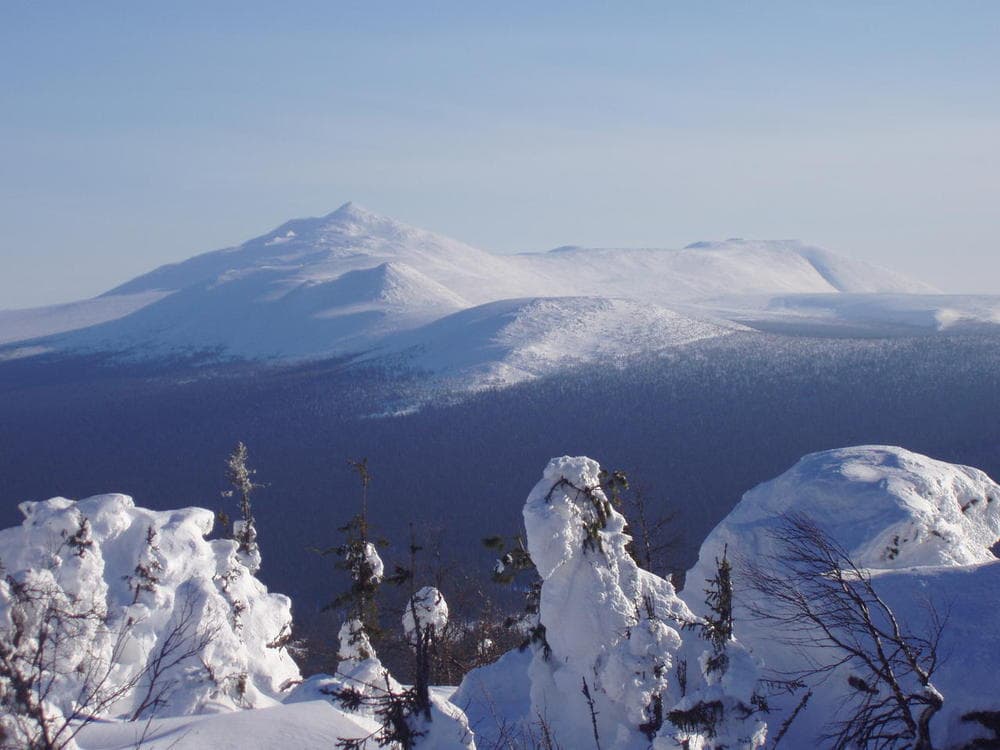
The Basegi Ridge is located in the western spurs of the Ural Mountains . The total length of the ridge is about 30 km. The Basegi name comes from an old Russian word ‘baski’, i.e. beautiful. The ridge features low mountains with gentle green slopes. The peaks are covered with stone placers (or boulder streams), with bizarre rocks, stony idols, arêtes and pillars. In some places, loose rocks form vast stone rivers.
There are relict plants of mountain-forest, subalpine and forest belts as well as subalpine meadows and mountain tundra. The ridge consists of three peaks – Northern, Middle and Southern Basegi . The highest point of the range is Mount Middle Baseg (994 m). In 1982, the territory of the ridge became a protected area of the Basegi Natural Reserve and only Northern Baseg (951 m) is officially open for tourists. There is a trail from the cordon Northern Baseg to the top of the mountain. When you go up, all the high-altitude belts show their secret treasures, animals feel free in the forests and not that afraid of a human. You can even meet a bear.
On a good clear day, you can see Middle Baseg and Southern Baseg , Oslyanka Mountain , the Kharius mountain range, Kachkanar, and provided the visibility is good, even the massif of the Konzhakov Stone.
In summer, the most common activities are hiking, cycling and hiking combined with some rafting on the Vilva or Usva rivers. In winter, there are ski and snowmobile expeditions.
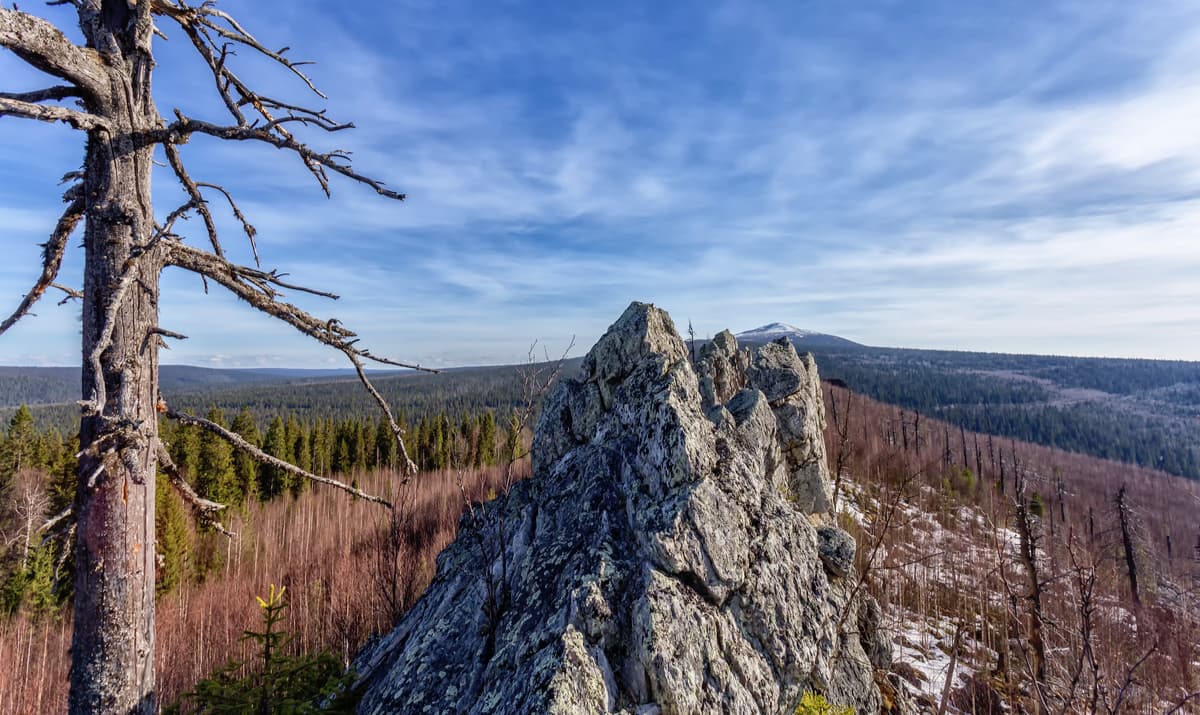
Kolpaki Mountain (614 m) is a hill with an almost perfectly rounded peak. Rumour has it, the name was given because of this round shape as it means ‘a cupola’ in Russian. The main landmark of the hill is the jagged array of stone pillars on the top, the so-called weathering columns of fanciful forms (up to 20 m high). The second name of the mountain is Long Fingers. The most famous of these rocks is the Devil’s Finger. A wooden staircase leads to the observation deck on one of the pillars, you can also have a picnic there. From the top, there is a magnificent panorama over Kachkanar Mountain, the Basegi Ridge, and some gold mines. A pine forest densely covers the slopes. There are a lot of tourists here at any time of the year, mountaineers often have training.
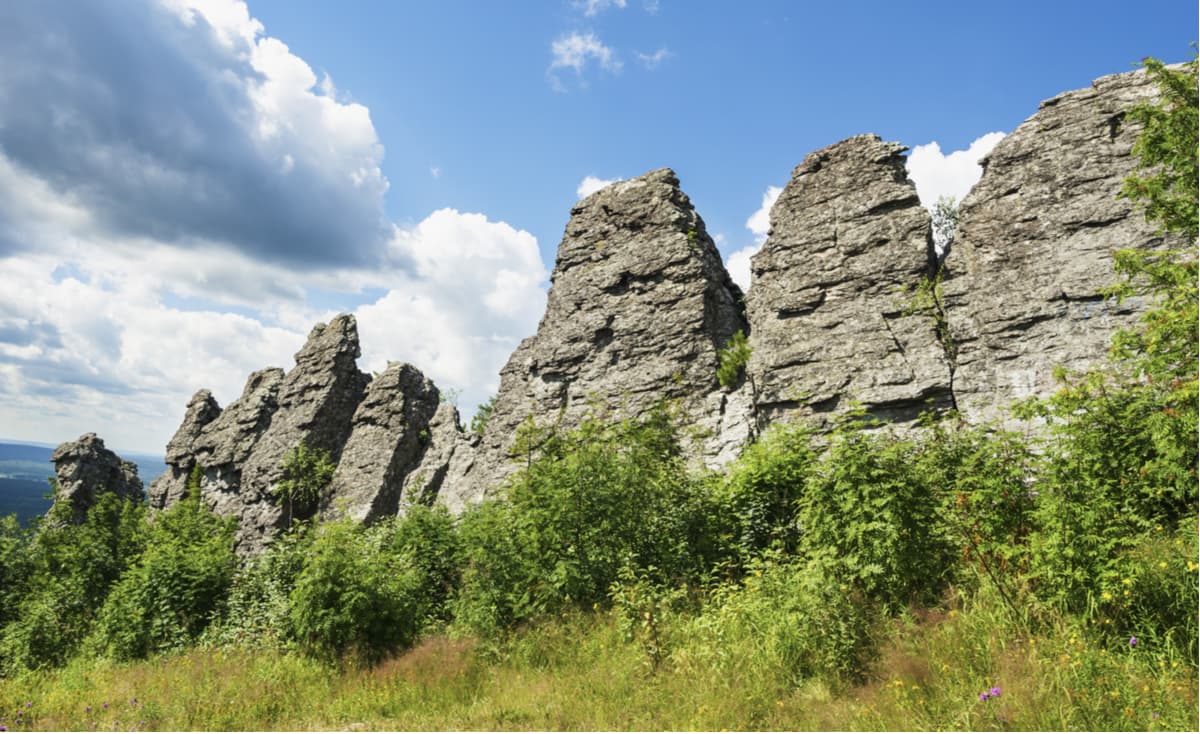
Mount Oslyanka (1,119 m) is somewhat reminiscent of a ridge shape since it stretches from north to south for almost 16 km. The mountain has stone placers, steep slopes and a plateau with stone pillars. It has several peaks, the main is located in the central part of the so-called ‘ridge’ and has a conical shape. In the olden days, the mountain was surrounded by prison camps. Now they are gone giving a way to tourists and outdoor enthusiasts who are lured by the strange shape of this mountain.
Every year in late February or early March a ski marathon is held on Mount Oslyanka . At the end of spring and in summer, you can hike to the top and combine it with good rafting on the Kosva River. From the top, you can see the Basegi Ridge and Konzhakov Stone. Oslyanka is a disputed territory because some researchers attribute it to the Northern Urals whereas others claim it to belong to the Southern Urals, especially since the border between them is quite conventional. But the climate and the nature of the mountain is typical for the Northern Urals. In winter, there is much snow and frequent severe frosts; there are avalanches on the slopes. In summer the weather is very changeable and you can experience massive heat waves alternating with heavy rainfalls.
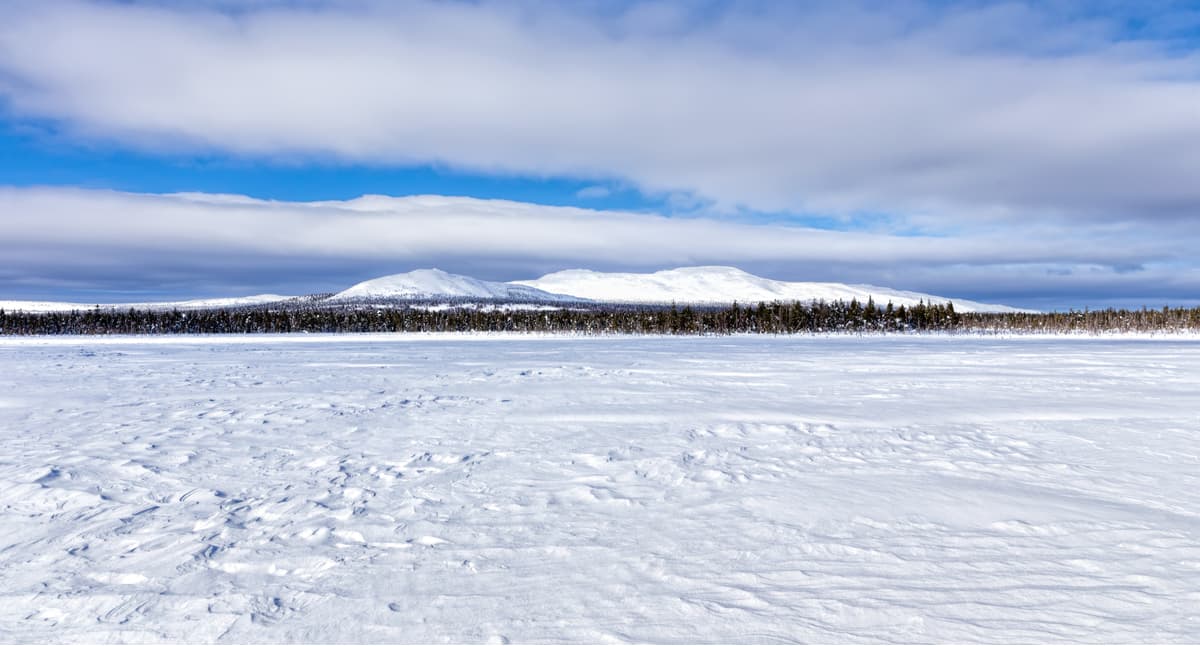
There is a real Stone Town situated near the village of Usva on the top of the Rudyan Spoy Ridge (526 m). This rocky town is also called a Fortress, a Devil's Hillfort or Turtles. When you look at the rocks here, they give an impression of a perfectly organized settlement. You can see narrow streets, corridors, arches and stone gates, houses and squares. This site reminds not of the ruins of a man-made ancient city, but of a kind of a rock labyrinth made of huge boulders. It can also be said that there are townspeople or representatives of the ancient settlement: the stones of the Small and Big Turtle, the Feathered Guardian, the Seal, various stone idols, etc. These rocks have a variety of different colors ranging from white and yellow to red and black, which is due to the sandstones encrusted on the surface of boulders. The Stone Town is divided into a Big Town and a Small Town standing somewhat 200-300 meters apart. There are only four stone idols in the Small Town. Many tourists, including rock climbers, come here at any time of year.
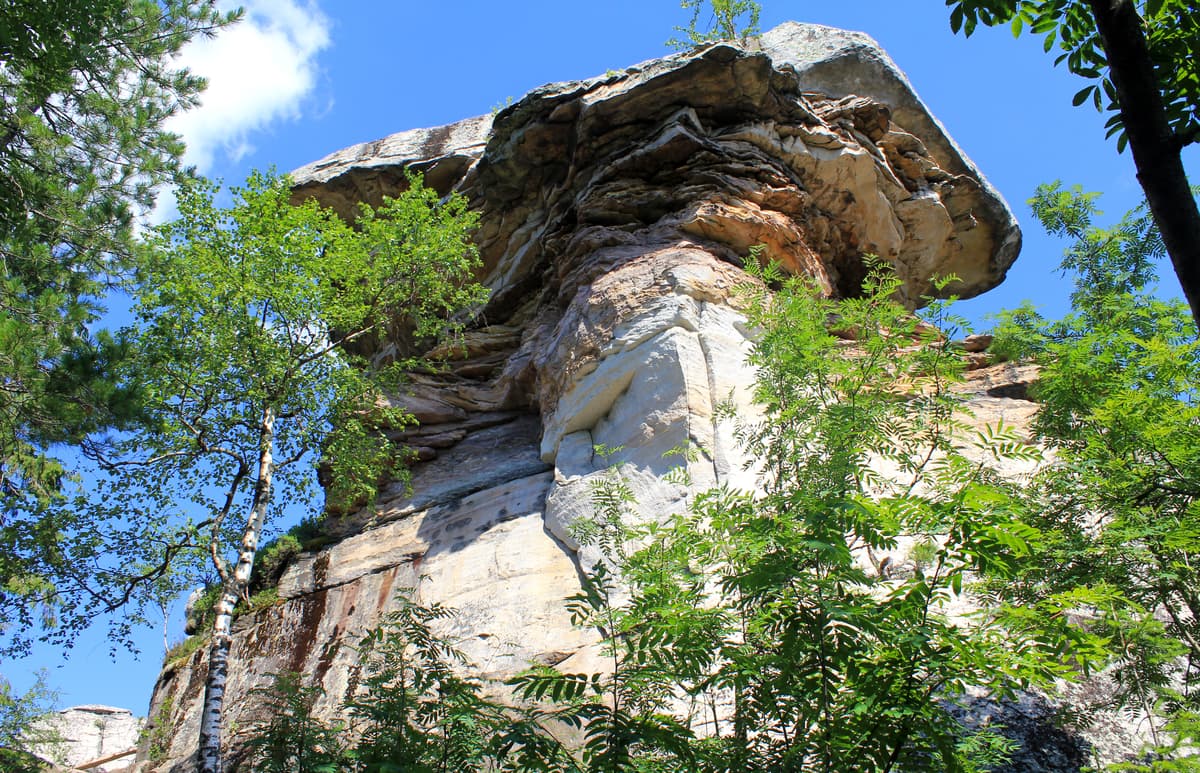
In recent years, the Perm Territory has created quite a few skiing bases, the largest and most famous of which is Gubakha located on Mount Krestovaya (471.3 m). The mountain is the symbol of the town of Gubakha nestled at the northern end of the Rudyan Spoy Ridge.
The List of ski centers in order of their remoteness from Perm City:
- Ivan-Gora (Gamovo village, 20 km from Perm)
- Zhebrei (Zhebrei village, 30 km from Perm)
- Glushata and Mountain (village Glushata, 30-32 km from Perm)
- Polazna (Konstantinovka village, 45 km from Perm)
- Yelniki (Dobryanskiy region, Yelniki village, 50 km from Perm)
- Uval and May Mountain (Krasnokamsk, 50 km from Perm)
- South Kamskie Gorky (South Kamskiy village, 65 km from Perm)
- Firefly and Stalagmite (near Kungur, 95 km from Perm)
- Kalinino (Kungur district, Kalinino village, 100 km from Perm)
- Aleksandrovka (Osinsky district, Novaya Aleksandrovka village, 130 km from Perm)
- Tacman and Ogonyok (Chusovoy, 135 km from Perm)
- Myshchelka (Osinsky district, Podgorodishche village, 150 km from Perm)
- Ashatli-Tulva (between Barda and Chernushka, 180 km from Perm)
- Gubakha (Pervomaisky settlement, 200 km from Perm)
- Sports school (Lysva town, 210 km from Perm)
- Snowflake and New Wave (Tchaikovsky, 260 km from Perm)
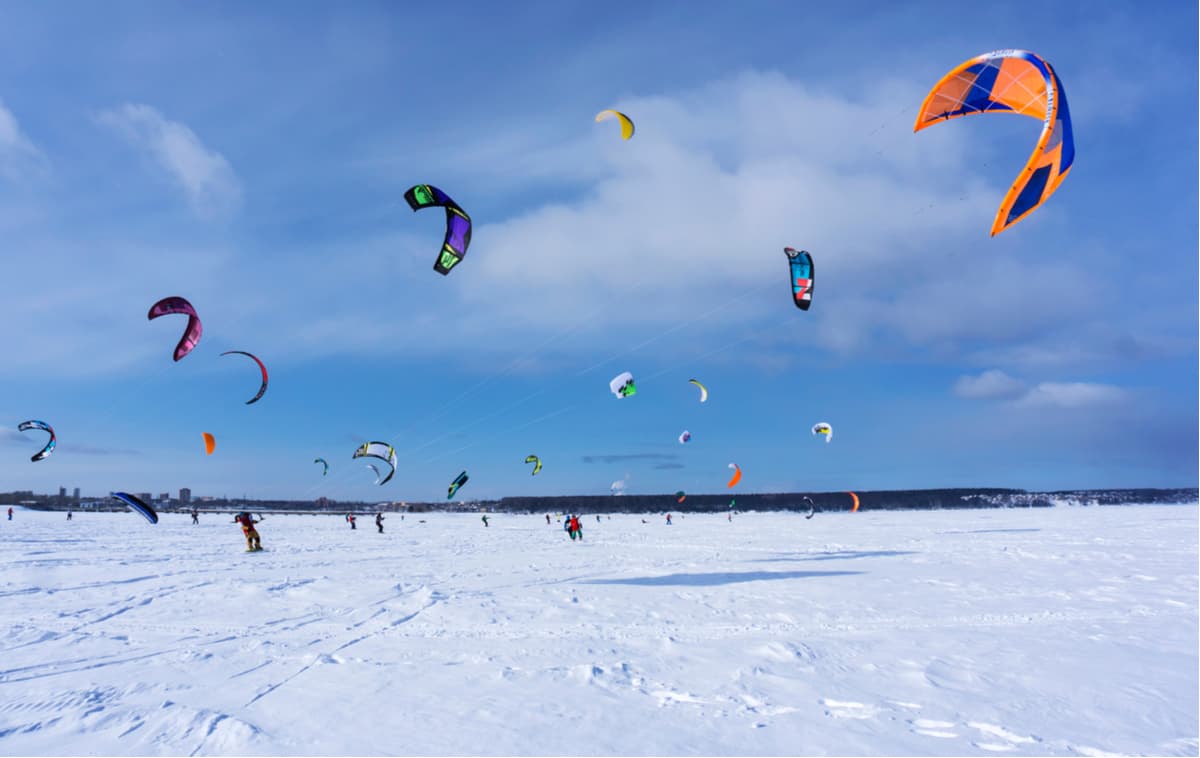
Due to abundant karst phenomena in the region, caves are found aplenty here. Nature was generous and gave the region such gems as the Divya Cave, the Kungurskaya Ice Cave, the Orda Cave, the Miracle Cave and many others. Some of them are equipped for excursions while others preserve their natural pristine state. Each of them is unique.
The Divya Cave is one of the longest caves in the Urals, and the top league the Perm Territory. The name Divya comes from the word ‘divo’, or ‘miracle’ and speaks for itself – it is one of the most beautiful caves in the Urals. The cave is located on the bank of the Kolva River, 12 km from Nyrob village. The total length of all its passages reaches 10 km. A small (about 1.5 m) horizontal entrance to the cave is located in a steep, forested coastal slope of Mount Diviy Kamen at an altitude of 90 m. A very narrow and low corridor leads to a series of grottoes and galleries. You will have to creep on your stomach in some places. In the cave, there is an amazing variety of calcite formations, it feels as if you are in a speleological museum. The cave is quite dry and clean despite a small stream and several lakes. On the surface of the lakes, you can observe an unusual phenomenon – the so-called calcite ice particles. The water temperature in the lakes is +4 degrees Celsius (+39 F) at any time of year. The air temperature in the cave varies from +4 to +8 degrees Celsius (+39 to +46 F).
The Kungur Cave is the oldest tour-guided gypsum cave in the world, the first excursions were here back in 1914. It is known and famous far beyond Russia for its ice grottoes. It is a real underground museum which has paths and lighting allowing you to see the cave in full splendor. There are about a dozen of the caves well-equipped so well in the whole world, thanks to which the Kungur cave is widely known outside the Urals. The entrance to the cave is located on Ice Mountain (Ledyanaya) on the right bank of the Sylva River, on the outskirts of Kungur in the village of Filippovka.
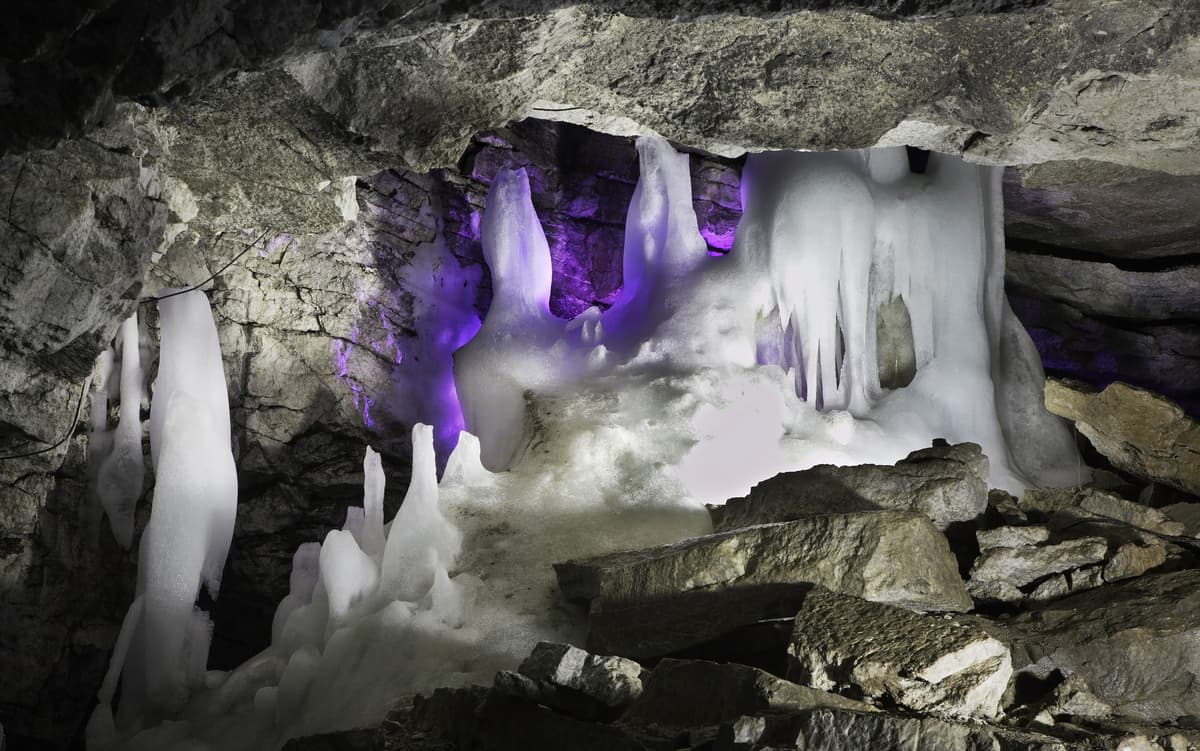
Ice Mountain is strewn with karst sites, there are funnels, sinkholes, karst trenches and many more. One of these is the Kungur ice cave which is about 5700-meter long. About 1300 m is available for tourists. This underground realm has 48 grottoes, 70 lakes, 146 organ pipes. It is called an ice cave for a reason. In most grottoes the temperature is around 0 degrees Celsius (+32F), and in some places it drops to - 15 degrees Celsius (+5F). From February to April, the cave is the most spectacular because then you can observe magnificent snow crystals of the Diamond grotto, as well as ice stalagmites and stalactites of the grottoes Polar, Cross, Vyshka. They create an interesting contrast with the unfrozen lakes in the Friendship of the Peoples Grotto and the Long Grotto. In summer, there is a grand laser show held in the cave. When you are in the cave, try to hear the "music" of the underground organ.
Visiting is possible only with a tour, groups are formed on site and enter the cave according to a schedule. There is a Karst Museum in the cave, where you can spend time waiting for the beginning of your visit. In winter, the Ice Mountain offers skiing and bagel riding (Firefly and Stalagmite Ski Centres).
The Orda (Ordinskaya) Cave is located 35 km from the Kungur Cave, near the village of Orda. It is a rather wild rustic cave, not equipped with any facilities, yet it is also quite famous. It is the longest underwater cave in the world in gypsum, which is a real paradise for cave diving (diving with scuba in caves).
It has 4 km of undersea and underwater passages and the longest siphon in Russia (935 m). You can go 15 meters down a good staircase and see only 300 meters of dry passages and halls. And then there are 1250 m of underground lakes which are an irresistible temptation for speleo-divers. At the entrance of the cave, there are beautiful banks of the Kungur River. In the village Orda, there is a local history museum exhibiting a nice collection of coins, watches, samovars, and there is the Prophet-and-Elijah's Church.
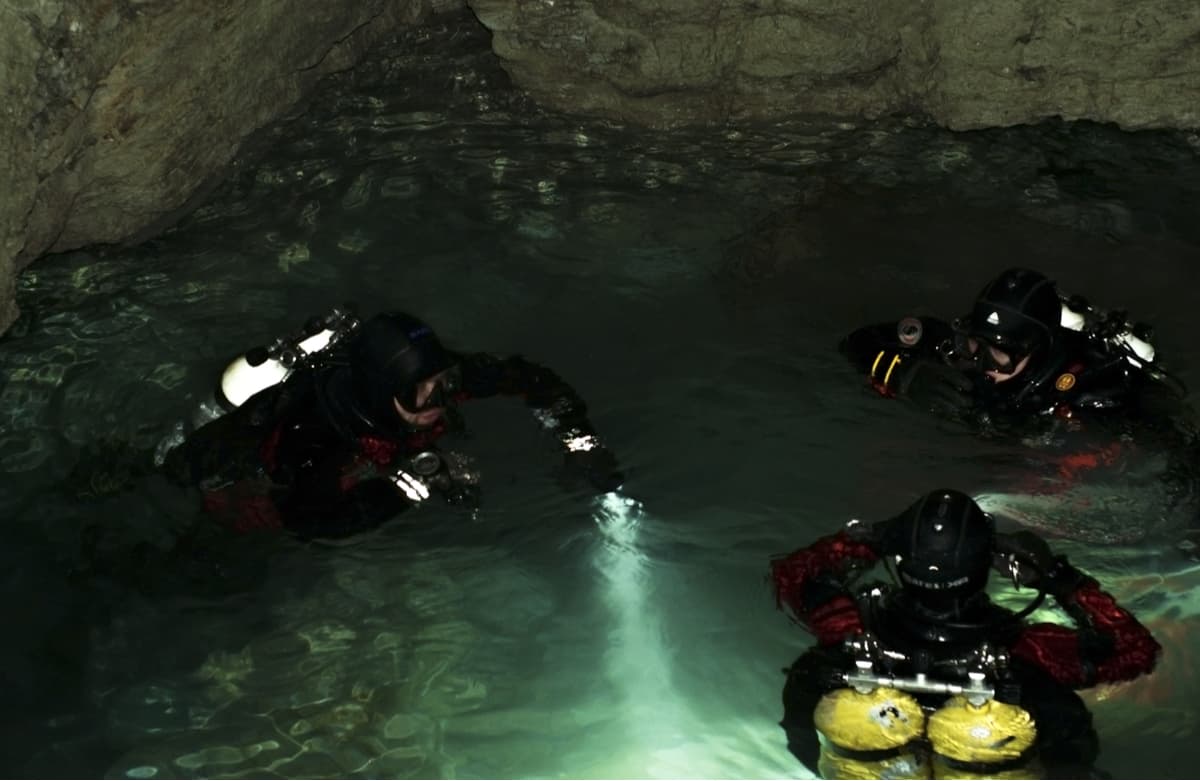
The Miracle or Wonderworker Cave got its name thanks to a lot of bizarre natural creations collected here. It is located on the right bank of the Ponysh River, not far from the place where it flows into the Chusovaya River. The entrance to it is located in a crevice on the slope of Mount Kladovoy Stone (at an altitude of about 50 m). The length of the cave is only 512 m, but the amount of wonderful things is mind-blowing. The walls of grottoes and passages are covered with picturesque limestone formations. Here you can find stalagmites, stalactites, dripstones, small lakes, stone waterfalls, cave pearls, etc. The cave is not equipped, thus you must have some speleological experience or an experienced guide to visit it. The easiest way to go is while rafting on the Chusovaya River. The best time for a hike is July or August. In winter, it is possible to go skiing or snowmobile hiking in the vicinity of the cave.
There are two specially protected natural areas of federal significance in the Perm Territory: The Vishersky Nature Reserve The Basegi Nature Reserve
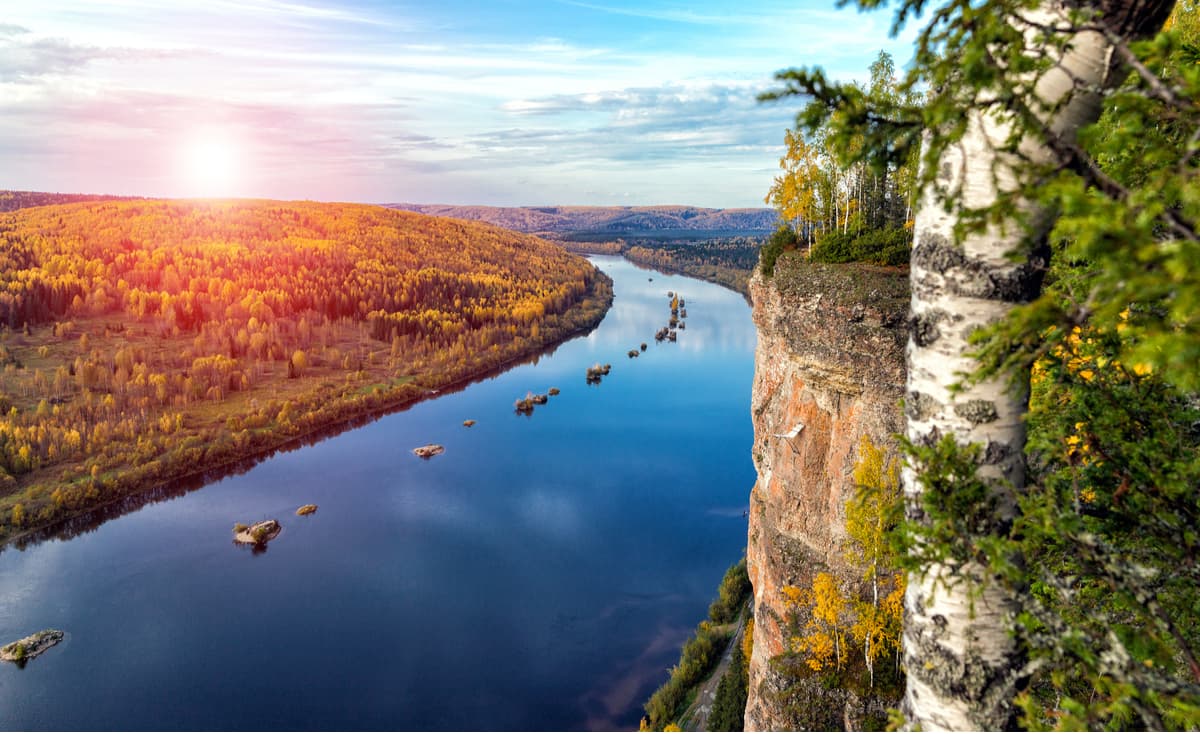
Besides, there are about 300 territories of regional importance and about 130 territories of local importance such as natural landmarks, reserves, protected sites, historical sites, etc.
The richest in natural landmarks is the Cherdyn district of the Perm Territory. There are many specially protected areas here. The following regions are the runners-up: the Krasnovishersky, Solikamsky, Bolshesosnovsky, Chusovskoy.
There is also a private park of the Valley of Waterfalls. Its creator and owner is Anatoly Vasilyev or just Egorych (a local witch doctor, healer, herbalist, author of many books). This park includes a man-made area with many springs and streams, sacred pagan places and an anomalous zone. The Valley of Waterfalls has already become famous as a place of UFO concentration, fluorescent glows of unknown origin and other mysterious phenomena. The visit season is from May to October. You can come here as a tourist or a volunteer.
The Perm Territory is rich in picturesque rivers with beautiful rocky banks, which will be interesting for water tourists and fishing enthusiasts. The most popular places are the Chusovaya, the Vishera, the Usva, the Vilva and the Koiva Rivers.
Most attractive for tourists is surely the Vishera which upper reaches are located in the Vishersky State Nature Reserve.
Apart from its pretty banks and splendid tall rocks towering over it, the Chusovaya River has many caves, Blue Lake, and Small Blue Lake.
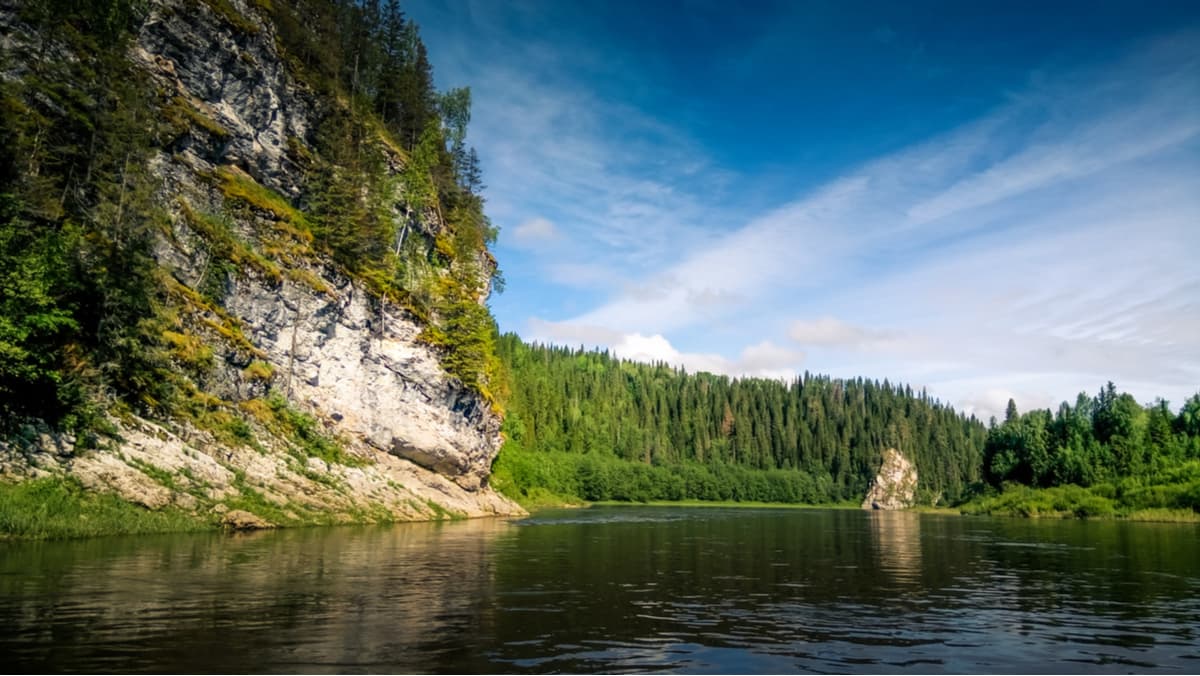
In spring, the Vizhay River, a left tributary of the Vilva River, is one of the most technically challenging rivers for rafting. In summer, it grows shallow and turns into a quiet brook. It starts on the slopes of the Vizhay Mountains . The best time for rafting is late April to late May. The water route starts from the village of Sarany which is 6 km away from the railway station Lucky. The water will not let you relax – sharp underwater and surface rocks are generously strewn along the way. In the coastal rocks, there are plenty of yet unexplored caves. When approaching the village of Pasha, rafting becomes easier, the river expands and forms some islands. However, it is here that the main obstacle of the Vizhay River, the Pashiya Cliff, is located. At the bridge after it, many tourist groups finish their rafting. However, if the rafting continues until Chusovoe village (another 70 km), you can see two more signature phenomena of the Vizhay River: the Big Funnel Rocks and the Great Pasha Cave located in the mountain nicknamed the Alpinist by tourists. The entrance to the cave is 30 m above the river. The 500-meter-long cave has 15 grottoes and a 12-meter waterfall that turns into a stream flowing into the underground lake.
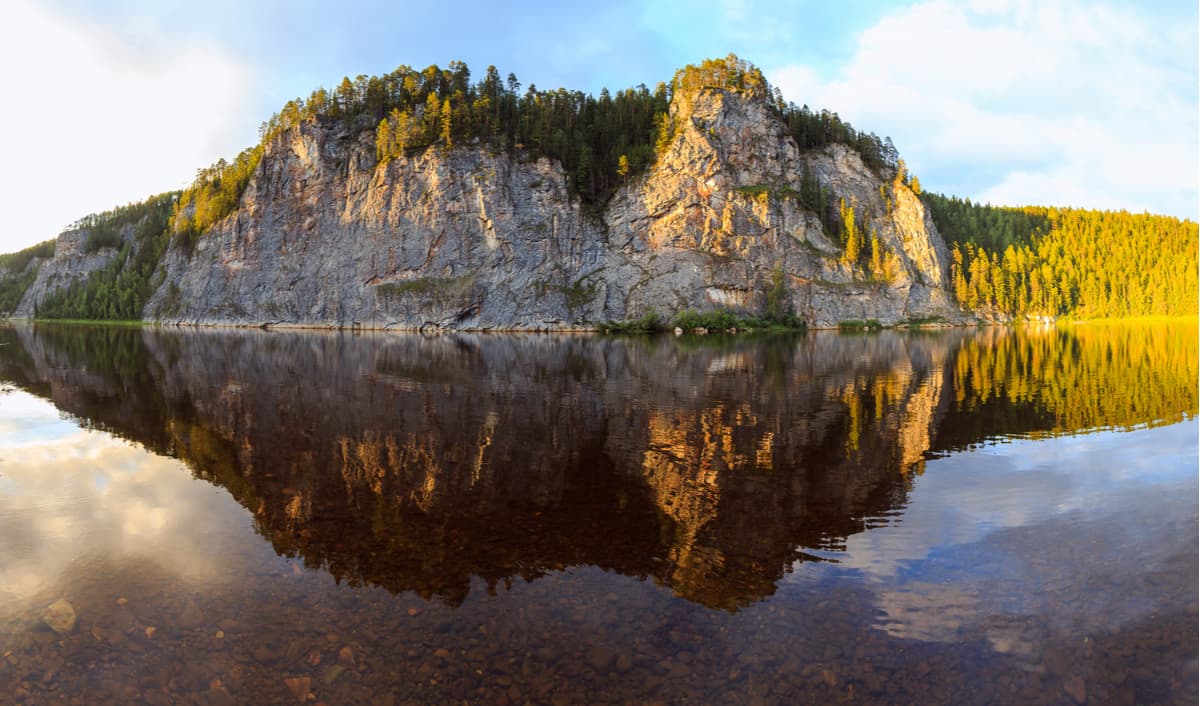
Rafting the Vilva River is a real test of your rafting skills as it is a truly mountain river. The river is located in the north-east of the Perm Territory and flows down the western slopes of the Ural Range. In springtime, right after the ice drift, the river becomes one of the fastest and most fertile in the region. In summer, the river shoals heavily in the upper reaches. Only well-trained rafters or those with an experienced guide can go down it. The river bed is full of turbulent places, rapids, rolls and swifts.
The main obstacle is a series of rapids called Nyrky. There is a dangerous artificial threshold created on the site of the gas pipeline crossing, there is a reinforced concrete pole and the difference in height reaches 1.5 m, which is better to bypass by land in case you are not sure you can master it safely. You can start rafting from Novovilvensky or a bit farther away from the mouth of the Korostelevka River. After the Nyrky rapids and before the Koldovaty (Sorcerer’s if translated poetically) brook, the Vilva flows past the Kosaya Plate Rocks. Beware of those since the riverbed in their vicinity features many rocks, boulders and rapids. Once you pass the mouth of the Koldovaty brook, you come into the Koldovaty rapids. Farther down the stream, there are more rocks in the river, e.g. the Upper Baran and the three Morozovsky islands after the confluence with the Izbnaya River.
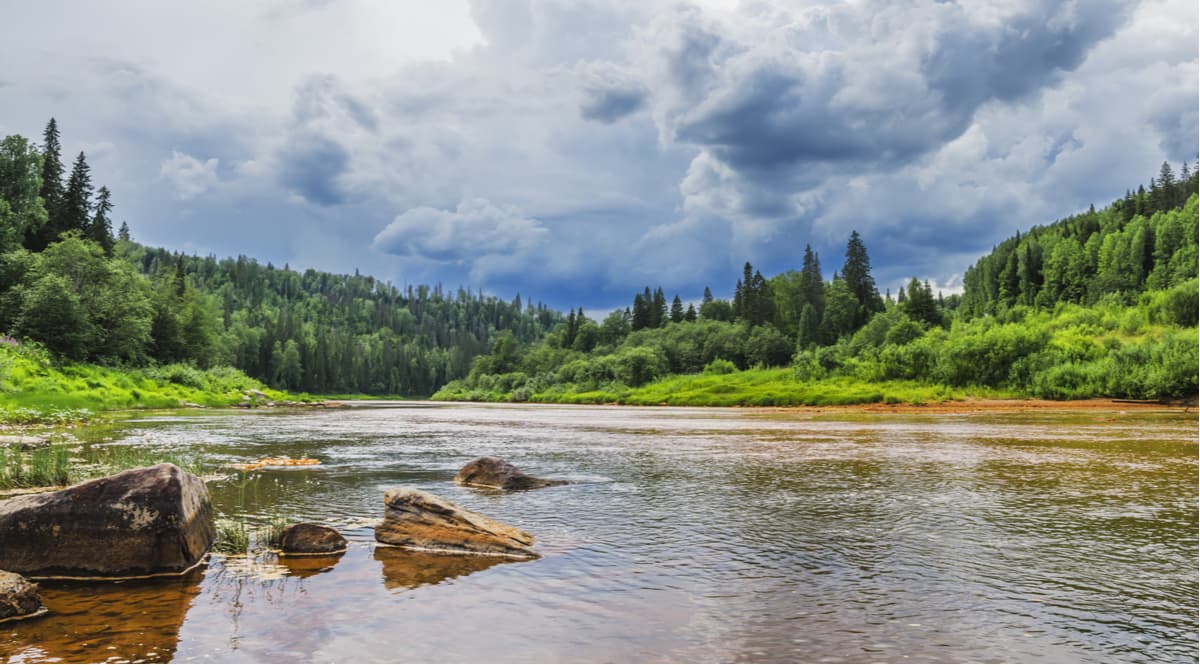
There is a picturesque bridge near the uninhabited village called Palace, and just in front of the village there is a picturesque Falcon (Sokolnaya) Mountain. It is an ancient volcano of about 600 million years old. Such geological formation is a rarity for the Urals. One can climb the mountain and admire the views of the Basegi Ridge and the river. The trails are heavily covered with shrubs and plants, hardly anybody gets here. After the Palace village, the Vilva River features fewer obstacles and islands. In the lower reaches and especially after Gremyachinsk town, the river is heavily polluted and becomes almost lifeless due to rampant industrial activities. The Vilva finally flows into the Usva and further into the Chusovaya River.
The Koiva River is considered the most picturesque tributary of the Chusovaya River. It enjoys crystal clear waters and is mainly mountainous, winding and narrow in its upper reaches. The Koiva has many rapids and a fast current. It is rafted mainly during the spring floods (in the first half of May). In summer, the river is shallow, but despite the fact that the speed of the current is dropping, it still remains passable for both kayaks and catamarans. However, during dry weather there may not be enough water for rafting (above the Biser village). Rafting the Koiva is technically more complex and interesting in spring, whereas in summer, even families with kids can do it. The route can be combined with the Chusovaya River rafting.
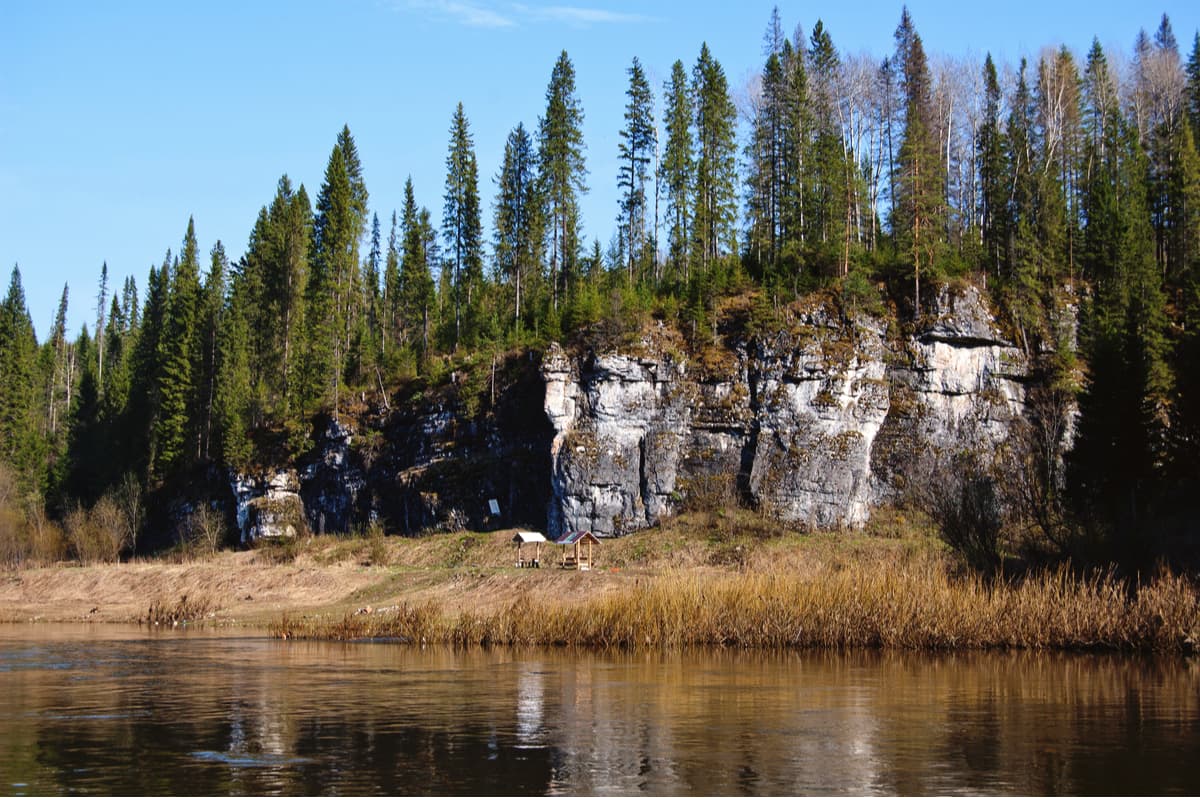
The trickiest part of the route is from the village of Old Biser to the village of Kusya -Alexandrovsky. It features the Fedotovsky threshold (heaps of boulders across the river that allow only for a very narrow gentle water drain in the middle; the threshold is not dangerous in summer), the Kalistratovskaya Shivera (it is a 500-meter long rapid, but not dangerous). Once you pass Ust-Tyrym village, there are several beautiful rocks some of which can be easily climbed (Strelny, Arochny, Dyrovaty). The Shaitan rock is fascinating as well. Near Kusya-Alexandrovsky settlement, there is a waterfall formed by the dam of the Kusya river that dumps excess water into the Koiva river. In spring, extreme sports lovers conquer the waterfall on catamarans. There is a road bridge downstream where many rafters finish their joy rides. Further downstream, before the Koiva flows into the Chusovaya River, there is a section with many artificial islands. There are quite a few stops along the banks of the Koiva River, and the river is popular with both rafters and fishing enthusiasts.
The Usva River is the largest tributary of the Chusovaya River. It originates on the eastern slope of Mount Khariusny Stone. The valley of the river is winding, but at the same time the river is quite calm. There are about 200 rapids which probably prompted the Komi people to call it ‘noisy water’. There are rocks along its banks. Rafting is done with catamarans and kayaks. The optimum time for a ride is when the water is still high and that is in the beginning of May, but you can go rafting all summer. It is necessary to keep in mind that in summer the river grows very shallow and only the lower section from the village of Usva to the Chusovaya river is available for boating.
There are several options of routes along the Usva. You can start rafting from the station Usva or from the village Srednaya Usva. You can finish rafting in different spots depending on the desired length and time of the route. At first, the river is narrow, only up to 5 m wide, heavily looped, and the current is fast. However, once the right tributary called the Bolshoi Yaz flows into the Usva, the river straightens and becomes calmer.
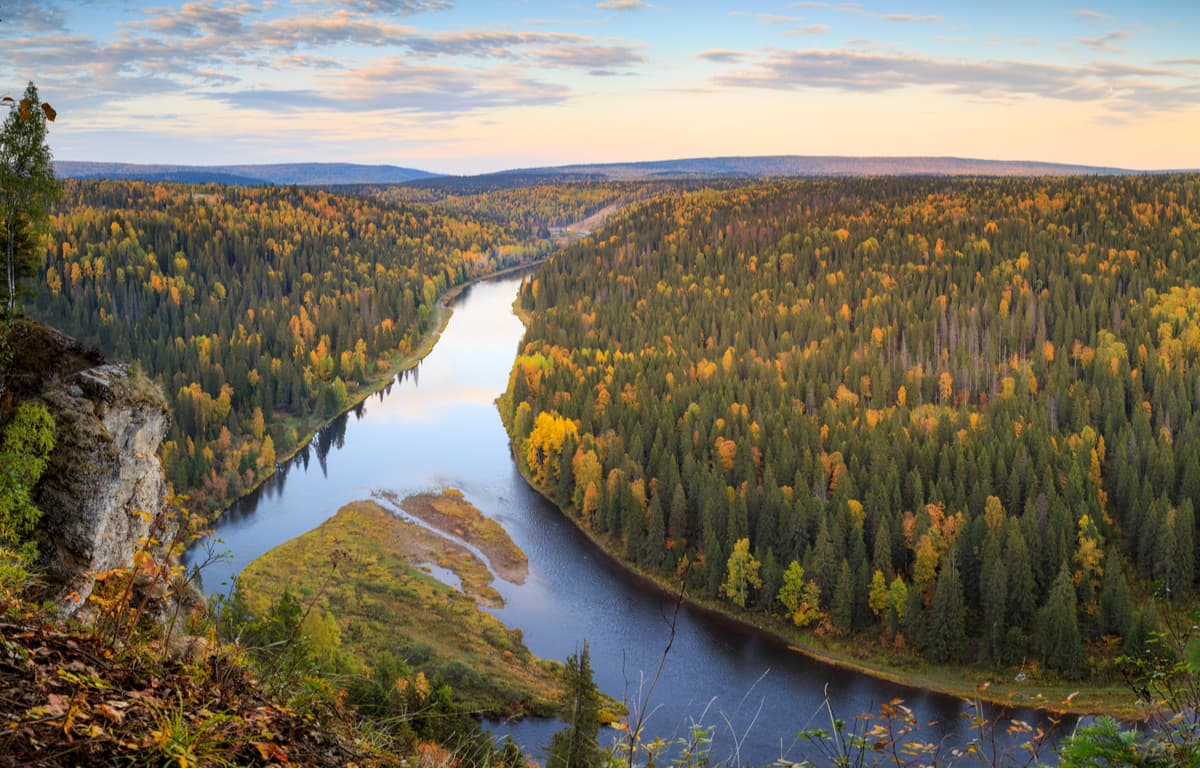
Close to the next right tributary called the Persha and after the destroyed bridge, there is a beautiful view of the North Baseg Mountain. Not far from this place is the border of the Basegi Nature Reserve . When you do downstream, there are rocks with equipped observation platforms from which you can admire the beauty of the mountains and panoramic views of the river. Then begins the most difficult part of the rafting – the Dry Rapids. For several kilometers, the riverbed features rocks and boulders occupying most part of the river. In summer during a drought, they turn into piles of stones, hence the word "dry" in the name of the rapids.
The section from the village of Srednaya Usva to Bezgodovo (about 130 km) lacks housing and roads, all you see is solid taiga and pristine nature. Several purest rivers flow into the Usva, i.e. the Big Khariusnaya, the Little Khariusnaya, the Big Baseg, the Little Baseg. This span of the route is a paradise for fishing enthusiasts. While rafting, drop to Gromovaya village and see some stone pillars (all lonely rocks along the river Usva are called pillars). There are 4 easy rapids from Shumikhinsky settlement to the station Usva. Three kilometres away from the village of Usva, the river has majestic rocks that stretch for several kilometers – this is the Usva Columns Massive; these rocks are up to 120 meters tall and you can see traces of corals in them, which proves there used to be a sea here a million years ago.
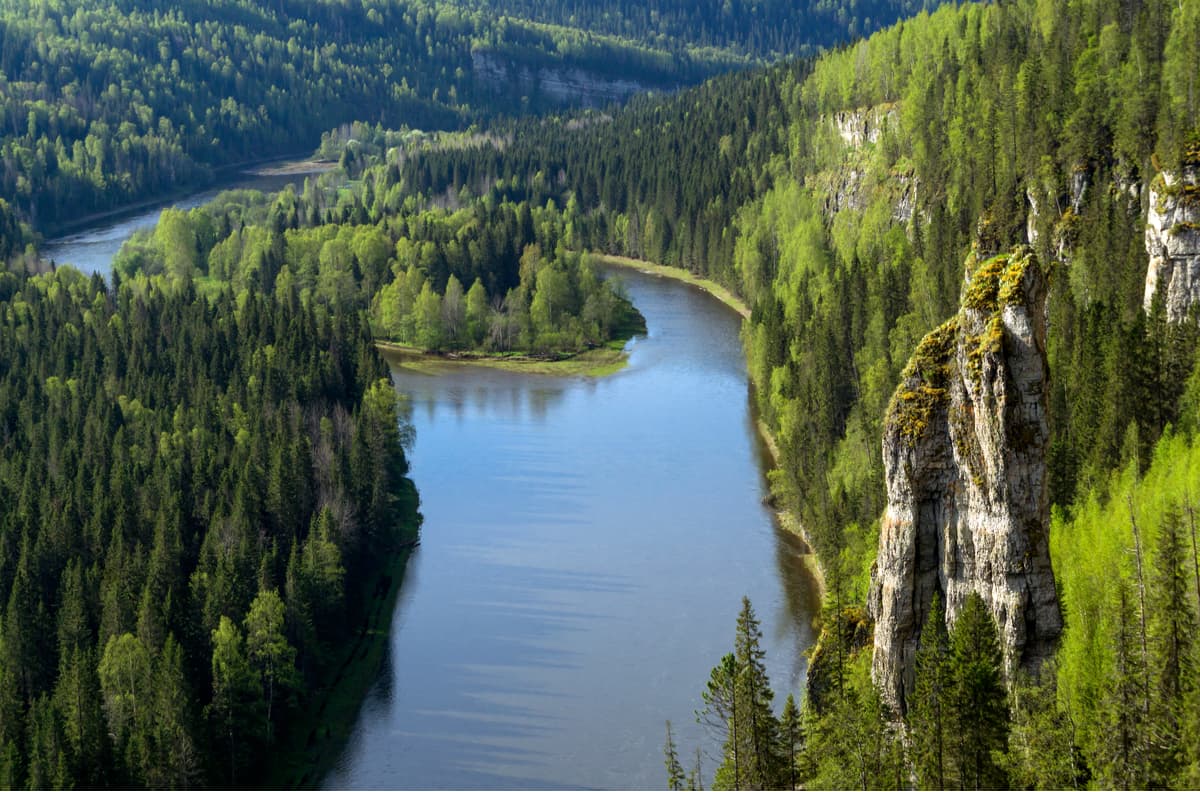
Once you pass those columns, the wonders don’t stop. There are mountains and rocks on the banks of the Usva, i.e. Overhanging Stone, Small and Big Log Stones (famous for their echos), Panorama Rock, Goat Stone (aka Strelny), Omutnaya Stone (aka Big Whirlpool). At Omutnaya Stone, the river depth reaches 6 meters, the water here is very cold even in summer because of the abundance of underwater springs. Then there are the Bastion cliffs and the Arch. You can finish the route in Chusovaya village where there is a railway station and access to automobile roads.
Another attraction of the Perm Territory is the Ice Falls called the Icicle. In spring and summer, 12 km from Usva railway station, on the right bank of the river Usva, streams and brooks flow down from Omutnaya Stone forming mini waterfalls about 5 m high. However, at this time of the year they are not very remarkable among dozens more similar cascading streams in the Urals. Quite a different thing happens in winter. The water freezes and turns those smallish waterfalls into a giant icicle 15 to 27 meters high. Every winter its size and shape is unique. The Perm people call this icefall very simply – the Icicle. The Icicle is not the only frozen waterfall here, there are a couple of smaller cascading icefalls in the region as well.
Alexandrovsk Blue Lakes are located in the north of the Perm Territory near the town of Alexandrovsk. These amazing man-made lakes have deep turquoise water. They were formed in the old abandoned quarries used for limestone mining (the Shavrinsky and Morozovsky quarries). It is the limestone dredge in the water that gives it such a beautiful color. You can get to the quarries by bus from Perm.
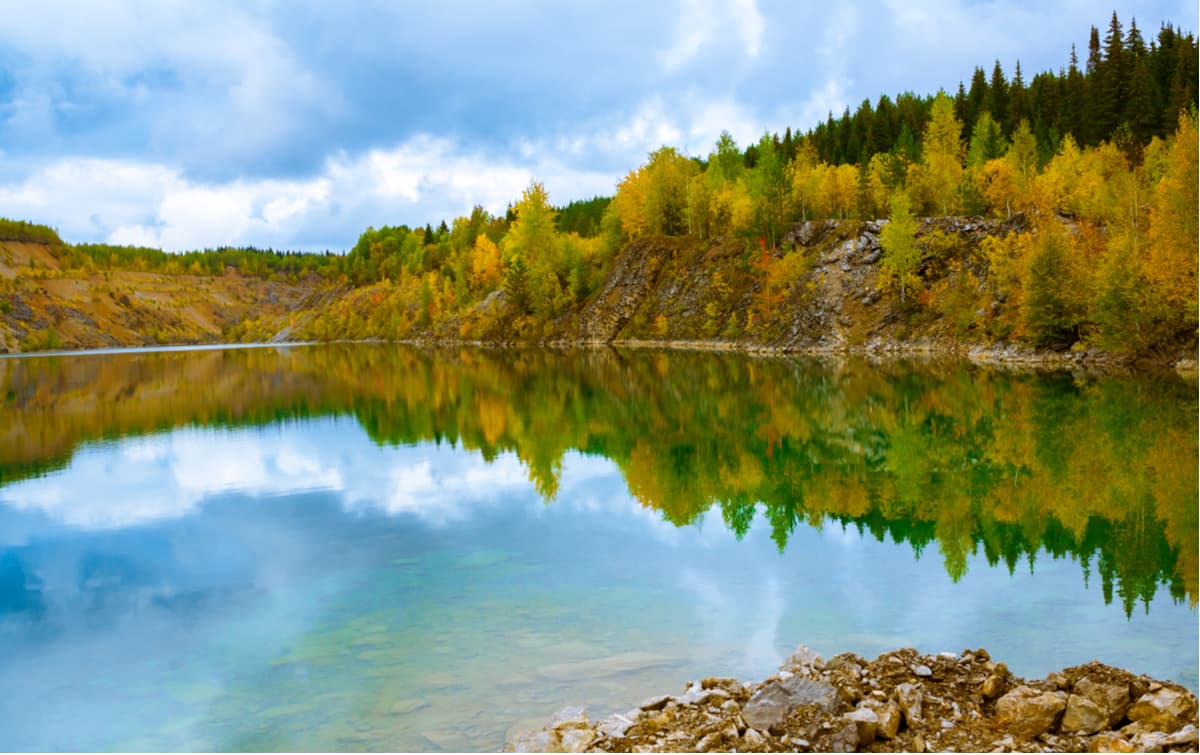
The White Sea in Berezniki is another unusual place in the Perm Territory that exhibits a striking contrast of landscapes. Just imagine walking in the forest, looking at giant trees and catching a glimpse of the Kama River now and then. But suddenly you step into a place when you see a turquoise surface of water resembling some tropical sea with a snow-white shore around it. In the background, you can see the factory buildings. This is Berezniki Soda Plant. The city of Berezniki is home to the soda industry in Russia. When soda is produced, the generated waste is a kind of pulp that is stored in a special storage facility. The White Sea is nothing but a pulp storage reservoir filled with water. The white color of the pulp gives the shores this whitish hues of a true tropical sea shore, and the azure color of the water is produced by various chemical compounds. You can get to the White Sea by bus from Perm to Berezniki. From the center of Berezniki, you should take a bus to the town of Usolie or Usolie district (go to the Boat Base station).
The following zoological nurseries operate in the region: The Cossack equestrian school, which includes a mini zoo and a horse farm. It is situated 140 km from Perm. An ostrich farm called The Strauss Park (50 km from Perm).
The best place to start your acquaintance with the Perm Territory is its capital – the city of Perm. The transport network here is well-developed. There is the Perm branch of the Sverdlovsk Railway, the Kama River Shipping Company, the Bolshoye Savino International Airport, and major roads connecting Perm to Moscow.
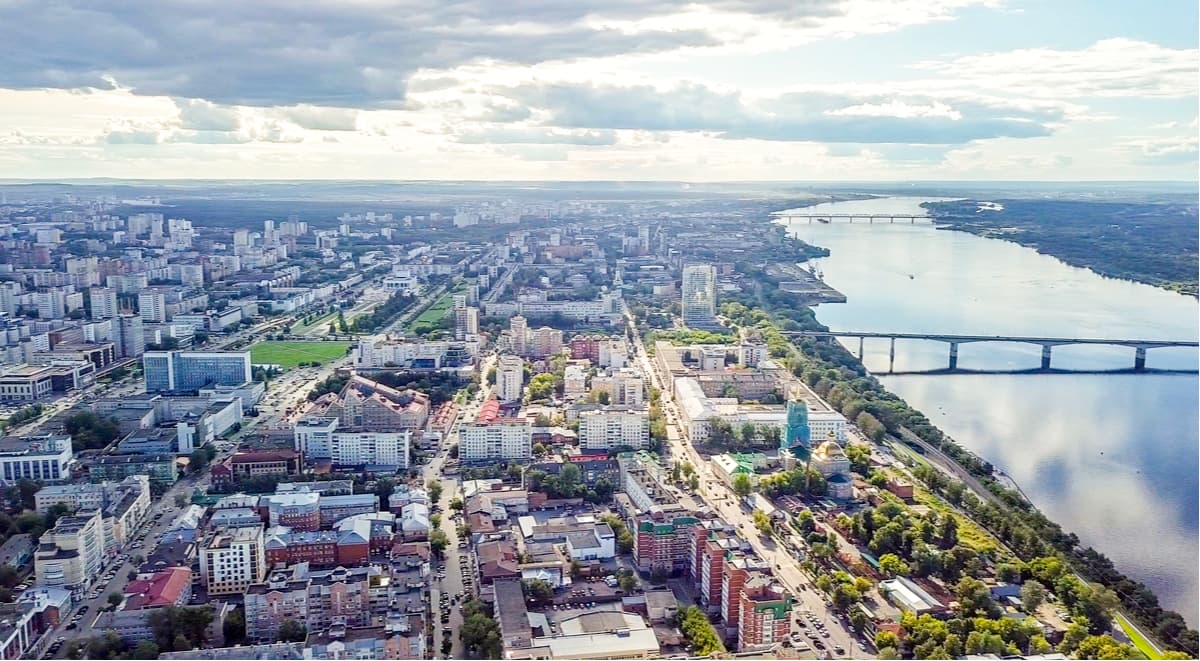
It is most convenient to get to the city of Perm by rail or by air.
Perm was founded in 1723 by Vasily Tatishchev, the man who laid foundations for many cities in the Urals. The city began as a small settlement at Yegoshikhinsky Copper Smelting Plant. Take a 2-hour walking route called The Green Line to acquaint with the city. Along the route, there is a green line on the road, and information boards near interesting sites.
Perm is located at a large waterway. Walk along the embankment of the river Kama, go to the Kommunalny bridge which is especially beautiful in the evening lights, and ride a river tram.
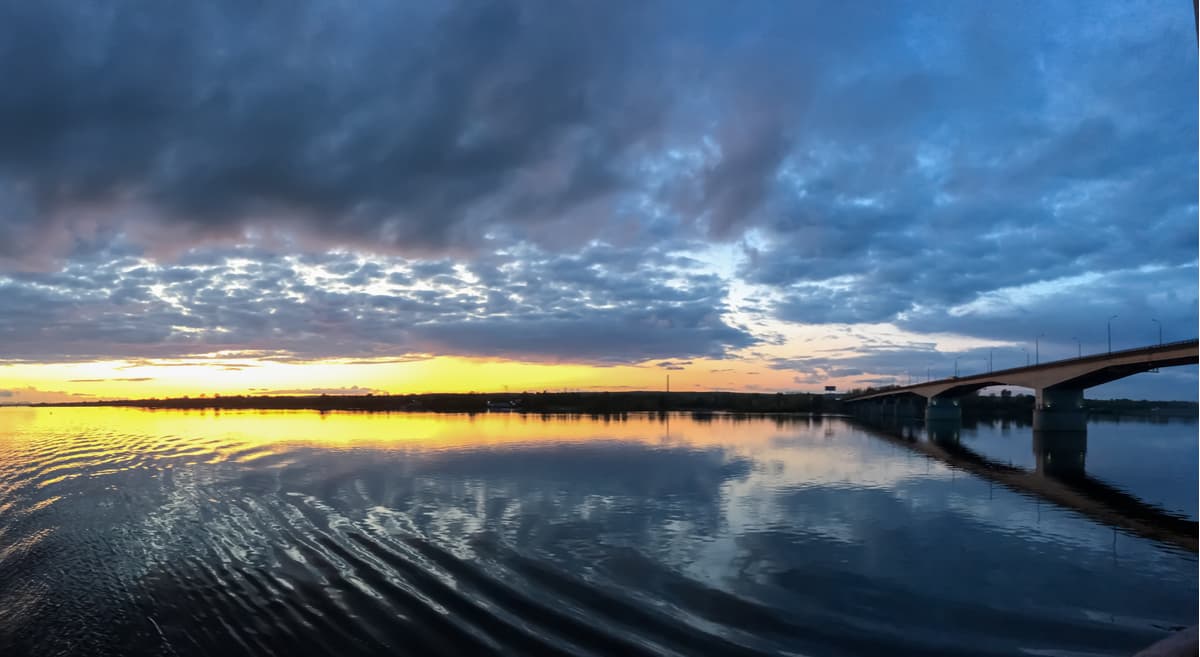
There are several museums in the city, e.g. Perm Art Gallery, Regional Museum, Museum-diorama December 1905 armed uprising in Motovilikha, PERMM Museum of Modern Art.
During the theatre season, you can go to one of the theaters: Perm Academic Theatre of Opera and Ballet named after P.I. Tchaikovsky, Theatre Ballet of Evgeny Panfilov, Perm Academic Theatre called Theatre-Theatre, and Perm Municipal Theatre At the Bridge.
There are many other interesting sights in the vicinity of Perm City. The most famous of them are
- The Architectural and Ethnographic Open Air Museum Khokhlovka (46 km from Perm)
- PERM-36 Memorial Museum (112 km from Perm). The only museum of political repressions in Russia. It is a former colony for political prisoners who served their sentence here during Stalin’s times.
- The Chusovaya River History Ethnographic Park (120 km from Perm). It is a fairy-tale place at the foot of Arinina Mountain. The park has kids’ skiing school of the Olympic reserve.
- Molebskaya anomaly zone, the locals call it Molebka (170 km from Perm). It is a local Bermuda Triangle, a kind of a mysterious place where you can observe unusual phenomena, including UFOs, various airglows and other interesting and strange phenomena.
- The Museum of Salt History in Solikamsk (213 km from Perm) which shows how salt was produced from the 17th to the 20th century in Russia. There is the only fully preserved salt plant in Russia which houses a museum as well.
Explore Perm Krai with the PeakVisor 3D Map and identify its summits .


WELCOME TO the tourism academy
Knowledge that moves the tourism industry, build relevance and cultivate stakeholder alignment. the tourism academy | tourismacademy.org makes transformative, engaging, and accessible tourism education possible for the tourism and destination industries. each of the programs we build is designed for adult learners by business psychologists and instructional design professionals. we use the latest in learning experience technology to ensure that your training programs are available when, where, and how stakeholders learn best., 145+ courses, available online and on demand., we're on a mission.
The Tourism Academy’s mission is to educate, empower and inspire the tourism industry. Subsequently, making it easier for travel professionals to advance their careers, grow their businesses and provide life-changing travel experiences to more people, sustainably.
The Tourism Academy is a registered 501(c)(3) nonprofit organization.

Education With Empathy™

We provide a distraction-free, easy-to-maintain, and customizable learning experience platform.

Instructional Design
We build custom courses so you can tell your story and transform your stakeholders.

70+ inspiring educators, subject matter experts, and industry leaders to bring meaning to your meetings.

Tools to enhance brand visibility, connect with target audiences, and grow within the tourism space.
Your People Deserve The Best Tourism Training
Organizations that offer online training generate 26% more revenue per employee. [ ELEARNING MAGAZINE ]

Why Work With Us
People first.
Education when, where and how your stakeholders learn best
Learning Culture
Innovation driven by our thirst for knowledge and understanding
We are true to our word, mission and promise
A full slate of analytics tools to measure KPIs

Some of our work
White-labeled learning environments , customized and easy-to-maintain courses , full-scale analytics, and branded certificates of completion. It’s what we do to make your training more effective and efficient.
Testimonials
Leaders in tourism development, destination marketing and association management are talking about us and the work we do to upskill, engage and inspire communities..

Tourist clusters and dominants (a case study of Perm krai)
- Spatial Features of Sectoral Development
- Published: 15 September 2012
- Volume 2 , pages 194–199, ( 2012 )
Cite this article

- A. I. Zyryanov 1 &
- S. E. Myshlyavtseva 1
83 Accesses
2 Citations
Explore all metrics
The article deals with the new system principles of planning for tourism development and inclusion of new areas in the tourist system in a region, based on the cluster-dominant approach using geographical methods. We describe a technique of spatial analysis and planning of tourism. From the geographical perspective, we analyze the concept of “tourist cluster”: the genesis of clusters, their territorial structure, and the relation of clusters to districts. The application of this approach in the design of the tourist area to the greatest degree allows one to consider the competitive advantages of a region. The zonal structure of a tourist cluster is analyzed on the example of a study of the mining and metallurgical Urals within Perm krai. We describe its system characteristics and main qualities of the dominant (the Us’va settlement), which may contribute to the promotion of the cluster in the market of recreational services.
This is a preview of subscription content, log in via an institution to check access.
Access this article
Price includes VAT (Russian Federation)
Instant access to the full article PDF.
Rent this article via DeepDyve
Institutional subscriptions
Similar content being viewed by others

Impact of tourism development upon environmental sustainability: a suggested framework for sustainable ecotourism

Sustainability of a local government-instituted ecotourism development: Tayak adventure, nature and wildlife Park in Rizal, Laguna, Philippines
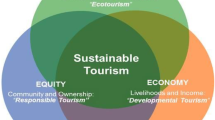
Socio-Economic and Environmental Impacts of Tourism on Local Community in Gilgit Baltistan, Pakistan: a Local Community Prospective
Baklanov, P.Ya., Territorial’ney struktury khozyaistva v regional’nom upravlenii (Territorial Economical Structures in Regional Administration), Moscow: Nauka, 2007.
Google Scholar
Zyryanov, A.I., Geograficheskie tekhonologii turisticheskogo proectirovaniya (Geographical Methods of Touristic Planning), Perm: Perm. Univ., 2010.
Zyryanov, A.I., Region: prostransvennye otnosheniya prirody i obshchestva (A Region: Spatial Relation between the Nature and Society), Perm: Perm. Univ., 2006.
Kostyaev, A.I., Territorial’naya differentsiatsiya sel’skokhozyaistvennogo proizvodstva: voprosy metodologii i teorii (Territorial Differentiation of Agriculture: The Methodology and Theory), St. Petersburg: SPbGUEF, 2006.
Kropinova, E.G. and Mitrofanova, A.V., A Cluster as the Economical and Geographical erm for Regional Studies of Tourist Activities, in Proceedings of the International Scientific Conference on the Theory of Social-Economic Geography: Current Status and Development Perspectives, Rostov-on-Don , May 4–8, 2010, 2010, pp. 284–287.
Mazhar, L.Yu., Territorial’nye turistsko-rekreatsionnye sistemy (Territorial Touristic-Recreational Systems), Smolensk: Universum, 2008.
Mironenko, N.S. and Tverdokhlebov, I.T., Rekreatsionnaya geografiya (Recreational Geography), Moscow: MGU, 1981.
Mitrofanova, A.V., Regional Touristic Cluster as the form of Spatial Organization of Touristic Activities (by an Example of Kaliningrad Oblast), Extended Abstract of Cand. Sci. Dissertation , Kaliningrad: KGU, 2010.
Teoreticheskie osnovy rekreatsionnoi geografii (Theoretical Principles of Recreational Geography), Preobrazhenskii, V.S., Ed., Moscow: Nauka, 1975.
Download references
Author information
Authors and affiliations.
Perm State University, Perm, Russia
A. I. Zyryanov & S. E. Myshlyavtseva
You can also search for this author in PubMed Google Scholar
Corresponding author
Correspondence to A. I. Zyryanov .
Additional information
Original Russian Text © A.I. Zyryanov, S.E. Myshlyavtseva, 2012, published in Izvestiya RAN. Seriya Geograficheskaya, 2012, No. 2, pp. 13–20.
Rights and permissions
Reprints and permissions
About this article
Zyryanov, A.I., Myshlyavtseva, S.E. Tourist clusters and dominants (a case study of Perm krai). Reg. Res. Russ. 2 , 194–199 (2012). https://doi.org/10.1134/S2079970512030112
Download citation
Received : 03 February 2010
Published : 15 September 2012
Issue Date : July 2012
DOI : https://doi.org/10.1134/S2079970512030112
Share this article
Anyone you share the following link with will be able to read this content:
Sorry, a shareable link is not currently available for this article.
Provided by the Springer Nature SharedIt content-sharing initiative
- tourism planning
- tourism and recreational environment
- tourism clusters and dominants
- recreational facilities
- zonal structure
- Find a journal
- Publish with us
- Track your research
It’s been a record-setting year for global travel – here’s how we make tourism inclusive and sustainable

Inclusive and sustainable travel and tourism includes supporting micro-, small- and medium-sized businesses. Image: Unsplash/Michael Barón
.chakra .wef-1c7l3mo{-webkit-transition:all 0.15s ease-out;transition:all 0.15s ease-out;cursor:pointer;-webkit-text-decoration:none;text-decoration:none;outline:none;color:inherit;}.chakra .wef-1c7l3mo:hover,.chakra .wef-1c7l3mo[data-hover]{-webkit-text-decoration:underline;text-decoration:underline;}.chakra .wef-1c7l3mo:focus,.chakra .wef-1c7l3mo[data-focus]{box-shadow:0 0 0 3px rgba(168,203,251,0.5);} Nicola Villa

.chakra .wef-1nk5u5d{margin-top:16px;margin-bottom:16px;line-height:1.388;color:#2846F8;font-size:1.25rem;}@media screen and (min-width:56.5rem){.chakra .wef-1nk5u5d{font-size:1.125rem;}} Get involved .chakra .wef-9dduvl{margin-top:16px;margin-bottom:16px;line-height:1.388;font-size:1.25rem;}@media screen and (min-width:56.5rem){.chakra .wef-9dduvl{font-size:1.125rem;}} with our crowdsourced digital platform to deliver impact at scale
- The global travel sector is experiencing a robust recovery, with tourists increasingly spending more on travel.
- Despite the overall positive outlook, some destinations struggle with operational challenges, including workforce issues and resource management amid rising tourist numbers and environmental concerns.
- The travel and tourism sector’s potential for advancing socio-economic prosperity is particularly impactful through the support of micro-, small-, and medium-sized enterprises.
The global travel sector forecast is in and it's sunny skies ahead. Through March 2024, consumer spending on travel remains strong, and passenger traffic has soared. Empowered by a strong labour market worldwide, tourists will be on the roads, air and seas once again, with more of people’s budgets on travel.
The latest report from the Mastercard Economics Institute, Travel Trends 2024: Breaking Boundaries , reveals that 2024 has already witnessed multiple record-setting days as consumer spending on leisure travel remains strong. The data shows that post-pandemic travellers continue to seek unique experiences rooted in local cultures while increasingly prioritizing spending on memorable events across sports, music and festivals.
The Mastercard Economics Institute’s analysis reveals that travellers also seek opportunities to extend their stays, prioritizing leisure for longer. For the first 12 months between March 2019 and February 2020, a trip’s average length of stay was about four days. As of March 2024, the average length of a leisure trip has edged closer to five days, which translates into an economic boost for the destinations and communities hosting them.
Have you read?
These are the top 10 countries for travel and tourism, what is travel and tourism’s role in future global prosperity, travel & tourism development index 2024, tackling tourism’s challenges.
Yet, while the overall outlook for travellers looks bright, that’s not the case for all destinations. Some tourism hotspots and lesser-known locales are facing growing challenges around operating conditions. The World Economic Forum’s Travel & Tourism Development Index (TTDI) 2024 highlights the ongoing constraints facing the global travel and tourism sector – including the lack of investment in skilled and resilient workforces and issues around resource management – cultural and natural – as destinations grapple with higher tourist visitor numbers and rising environmental concerns.
The report offers travel and tourism decision-makers recommendations around how the sector can take a more active role in tackling social challenges across socio-economic prosperity, peace and cultural exchange. As the industry accounts for approximately one-tenth of global gross domestic product and employment , the public and private sectors must work together to ensure future tourism development is, first and foremost, inclusive and sustainable.
Supporting the backbone of travel and tourism
As the TTDI 2024 notes, one area where the sector’s potential in advancing socio-economic prosperity can be particularly impactful is in the economic empowerment of micro-, small- and medium-sized enterprises (MSMEs). According to the World Travel & Tourism Council, more than 80% of travel and tourism businesses fall under this category.
Policies and investments promoting the adoption of digital solutions and enhancing digital skills development while improving access to credit can provide a major boost to tourism-focused MSMEs.
In Costa Rica, the Instituto Costariccense de Turismo, a member of Mastercard’s Tourism Innovation Hub , is championing such an approach to ensure increased tourist traffic results in better opportunities for MSMEs. Last year, the institute launched Tico Treasures , a platform facilitating tourist connections with Costa Rica’s Crafts with Identity programme, a group of 17 artisan collectives across the country. The platform allows visitors to discover local Costa Rican products, learn about artisan communities and then purchase and ship the goods back to their home country – all through one experience.
The programme is an example of public-private collaboration, including backing from Correos de Costa Rica, Banco de Costa Rica and the Instituto Costariccense de Turismo. Its objectives are multifold: delivering more authentic experiences for tourists, expanding citizens’ access to the digital economy and contributing to MSME resilience.
Protecting future environments
There are also novel approaches to solving destinations’ sustainability challenges underway. A key role of the Travel Foundation , a global non-government organization, is to facilitate innovative public-private collaborations in tourism that accelerate and scale sustainable solutions. One notable example is in Scotland, where the national tourism organization VisitScotland is partnering with the Travel Corporation, a global tour operator, to help decarbonize the destination supply chain. Both organizations are pooling their insights, data and expertise to support local businesses, develop new ideas for reducing carbon footprints and identify barriers to a green transition.
The learnings from this and other projects led by the Travel Foundation will be shared to influence future policy, investment and product development decisions at national and global levels. By combining public sector resources and capabilities with private sector technological expertise, travel and tourism decision-makers can enact policies and programmes that balance tourism growth with environmental protection, providing a nuanced approach that works for unique destinations.
It’s an important time for the sector – to leverage travel and tourism’s robust recovery and advance socio-economic prosperity, fuelling a more inclusive future for our treasured destinations. By accelerating collaboration between governments, destination management organizations and technology companies, we can ensure destinations, the communities that power them and the environments they inhabit are at the heart of all future tourism development.
Don't miss any update on this topic
Create a free account and access your personalized content collection with our latest publications and analyses.
License and Republishing
World Economic Forum articles may be republished in accordance with the Creative Commons Attribution-NonCommercial-NoDerivatives 4.0 International Public License, and in accordance with our Terms of Use.
The views expressed in this article are those of the author alone and not the World Economic Forum.
The Agenda .chakra .wef-n7bacu{margin-top:16px;margin-bottom:16px;line-height:1.388;font-weight:400;} Weekly
A weekly update of the most important issues driving the global agenda
.chakra .wef-1dtnjt5{display:-webkit-box;display:-webkit-flex;display:-ms-flexbox;display:flex;-webkit-align-items:center;-webkit-box-align:center;-ms-flex-align:center;align-items:center;-webkit-flex-wrap:wrap;-ms-flex-wrap:wrap;flex-wrap:wrap;} More on Trade and Investment .chakra .wef-17xejub{-webkit-flex:1;-ms-flex:1;flex:1;justify-self:stretch;-webkit-align-self:stretch;-ms-flex-item-align:stretch;align-self:stretch;} .chakra .wef-nr1rr4{display:-webkit-inline-box;display:-webkit-inline-flex;display:-ms-inline-flexbox;display:inline-flex;white-space:normal;vertical-align:middle;text-transform:uppercase;font-size:0.75rem;border-radius:0.25rem;font-weight:700;-webkit-align-items:center;-webkit-box-align:center;-ms-flex-align:center;align-items:center;line-height:1.2;-webkit-letter-spacing:1.25px;-moz-letter-spacing:1.25px;-ms-letter-spacing:1.25px;letter-spacing:1.25px;background:none;padding:0px;color:#B3B3B3;-webkit-box-decoration-break:clone;box-decoration-break:clone;-webkit-box-decoration-break:clone;}@media screen and (min-width:37.5rem){.chakra .wef-nr1rr4{font-size:0.875rem;}}@media screen and (min-width:56.5rem){.chakra .wef-nr1rr4{font-size:1rem;}} See all

How an affordable cross-border delivery service will unlock the promise of millions of SMEs in Southeast Asia
Pete Chareonwongsak
June 17, 2024

IDEA: Investing in the Digital Economy of Azerbaijan

Digitalization is disrupting global trade – here's how AI can help customs and businesses to respond
Sebastian Klotz, Steve Barr and Jimena Sotelo
June 6, 2024

TradeTech is revolutionizing global trade
June 5, 2024

US hikes tariffs on Chinese imports, and other global trade stories to read this month
Guillaume Dabré
May 24, 2024

Are these five trends disrupting or driving logistics growth?
Ali Alwaleed Al-Thani and Sheikh Mohammed bin Hamad bin Faisal Al-Thani

Taylor Tourism: New Data Reveals Singer's Eras Tour Is Driving Interest in Small Towns and ‘Destination Dupes'
If you purchase an independently reviewed product or service through a link on our website, Rolling Stone may receive an affiliate commission.
Taylor Swift fans flocked to Liverpool last week for the first of her sold-out "Eras Tour" UK dates , but it wasn't just Liverpool locals in the crowd. Among the more than 55,000 Swifties at Anfield Stadium were fans who had traveled from as far as India, China and the Philippines, in addition to seemingly thousands of people from North America.
While they don't share exact booking data, travel site Expedia says search interest in Liverpool has increased by as much as 875% over last year, likely due to Swift announcing her tour dates in the city. Searches for Warsaw, Poland, meantime, have increased by a whopping 1130%, per Expedia, with bookings tied to Swift's concert there in August. Aside from those top two cities, Swifties drove up Expedia searches for May to August by almost 65% for cities that are part of the singer's 2024 European tour . Call it the "Taylor tourism effect."
In a recent Expedia survey, nearly 70% of respondents said they would be more likely to travel to a concert outside their hometown, especially if it was cheaper . More than 40% said they'd see traveling for a concert as an excuse to visit a new place. That has not only increased bookings on Expedia to lesser-known destinations (think Liverpool over London), it has also become a major driver of those local economies.
It isn't just Swift who is driving business for " tour tourism " - last year saw U.S. fans flocking to Europe for Beyonce's "Renaissance Tour," and unexpected cities on Expedia's list of top tour tourism destinations this year include Kuala Lumpur (where Dua Lipa is playing November); Edmonton (where Avril Lavigne, Zach Bryan and Bruce Springsteen will make stops this year); and Mexico City, which will welcome Jonas Brothers, Niall Horan and The Killers, among others. While hotel prices run into the high-hundreds for major cities like New York and Chicago, Expedia has stays available from $91 in Kuala Lumpur, and $119 in Mexico City and Warsaw, proving these so-called "destination dupes" may provide the best value for concert goers.
The top summer ticket aside from Swift? According to Expedia, it's Justin Timberlake who is leading search interest on the site, with his upcoming concerts in Amsterdam and Munich "driving higher demand" in hotel bookings than Swift. Here in the U.S., Expedia is seeing an increase in bookings for small towns like Hershey, Pennsylvania and Lexington, Kentucky, with travel searches up 1400% and 800% respectively for more affordable stays there tied to Timberlake's dates.
While Expedia is best known for offering accommodations and experiences (think guided tours and sightseeing packages), the site also has sports and concert tickets available as part of its resale marketplace. Tickets to 2024 Eras Tour dates start at $408 as of this writing, all backed by Expedia's money-back guarantee.
As for tips on how to score the best deals to see Swift (and other artists): in addition to searching for the less mainstream destinations mentioned above, Expedia says to consider commuting to the concert rather than staying in the exact city where the show is taking place, which can often shave a few hundred dollars off accommodations. The site also notes that Saturday night is often the most expensive night to stay in a hotel. If an artist is playing multiple dates, try and opt for midweek or Sunday.
More from Rolling Stone
- Taylor Swift Debuts 'Carolina,' 'The Manuscript' Live at Liverpool Show
- Joe Alwyn Talks Taylor Swift Breakup for First Time: 'Hard Thing to Navigate'
- How to Watch 'House of the Dragon' Season 2 Online


Official websites use .mass.gov
Secure websites use HTTPS certificate
A lock icon ( ) or https:// means you’ve safely connected to the official website. Share sensitive information only on official, secure websites.
- search across the entire site
- search in Governor Maura Healey and Lt. Governor Kim Driscoll
- search in Executive Office of Economic Development
- This page, Healey-Driscoll Administration Launches New “Made Possible” Tourism Campaign to Promote State History and Culture, Attract New Travelers, is offered by
- Governor Maura Healey and Lt. Governor Kim Driscoll
- Executive Office of Economic Development
Press Release Healey-Driscoll Administration Launches New “Made Possible” Tourism Campaign to Promote State History and Culture, Attract New Travelers
Media contact for healey-driscoll administration launches new “made possible” tourism campaign to promote state history and culture, attract new travelers, karissa hand, press secretary.
Boston — Today, Governor Maura Healey announced a new tourism campaign called “Made Possible” to showcase Massachusetts as a dynamic travel destination for visitors across the globe and the best place to live, raise a family, and build a business. The campaign builds off of the administration’s “Massachusetts For Us All" campaign, which ran in the Summer of 2023, as well as proposed investments in arts, culture and tourism in the Mass Leads Act.
“Our state is full of go-getters and change-makers, each with an amazing story to tell and invaluable contributions to make in our diverse communities,” said Governor Healey . “Everyone is welcome here, and we proudly showcase this on a global scale. The Made Possible campaign will engage a new generation of travelers and future residents and demonstrate that anything is possible here in Massachusetts.”
“Through Made Possible, visitors can find themselves in every corner of Massachusetts – in our small businesses, downtown areas, and cultural centers,” said Lieutenant Governor Kim Driscoll . “Through this new campaign, we want residents and visitors to feel connected to our state’s rich heritage and legacy of possibility. We look forward to sharing our story.”
The campaign will emphasize digital and social engagement and aim to increase tourism to Massachusetts’ many historic, cultural, and natural destinations, from Boston to the Berkshires and Provincetown to Plymouth. Launching in June during Pride Month, the campaign will also highlight Massachusetts as a welcoming place for the LGBTQIA+ community through creative billboards and digital advertising in New England states, Texas, and Florida. The campaign will grow over the next 12 months, targeting domestic travelers through a mixed media approach that will include television, radio, digital, print, and billboards that target consumers who are planning travel to Massachusetts.
Made Possible’s creative builds off of the successful launch in 2023 of “Massachusetts For Us All,” which ran from June 2023 to September 2023 on highway billboards and social media in Texas, Florida, New York, and New England, promoting Massachusetts as a welcoming and safe place for all. The campaign resulted in 1.6 million impressions and 12,000 website visits.
“Massachusetts is a hub of innovation, new ideas, and the spirit of possibility, and we are excited to show the world our vibrant history and promising future through this new campaign,” said Economic Development Secretary Yvonne Hao. “Made Possible will help drive visitors to our many cultural, recreational, and historic sites and support local and regional economies throughout the state.”
“From our revolutionary roots and rich historical sites to our beautiful mountains and picturesque coastlines, Massachusetts has it all,” said Massachusetts Office of Travel & Tourism Executive Director Kate Fox . "We're teaming up with Hill Holliday to welcome everyone to explore our vibrant cities and towns, stunning landscapes, and endless adventures. Massachusetts awaits!"
The Massachusetts Office of Travel and Tourism selected Hill Holliday, the award-winning integrated creative and media agency, as the creative partner developing and implementing the Made Possible campaign.
“Since its founding in 1968, Hill Holliday has been an advocate for Massachusetts and all its unique offerings across this amazing state. We are incredibly proud to represent the state we call home,” said Peter Nicholson, Chief Creative Officer, Hill Holliday . “This summer, we will launch a bold and fresh integrated campaign that celebrates our many destinations as well as our unique culture.”
In March 2024, the Healey-Driscoll administration unveiled the Mass Leads Act , the administration’s first economic development bill that contains the tools and resources needed to make Massachusetts the best place in the nation for individuals to pursue rewarding careers and for companies to start, scale, and succeed. The bill makes critical investments in the tourism, arts, and culture industries, including $40 million for capital improvements at tourism assets across the state, $50 million to improve cultural facilities like museums and theaters, the creation of an artist in residence and poet laureate for the state, and support for Massachusetts’ celebration of the 250th anniversary of the American Revolution.
About Hill Holliday
Hill Holliday is proud to be one of the top creative marketing agencies in the country, with over 200 cross disciplinary talents across the network. Since 1968, Hill Holliday has been on a mission to create transformative work that doesn’t just turn heads and stop thumbs, but consistently drives growth. Blending communications planning, media, and technology with superior creative, the agency approaches problems holistically to create work that punches above its media weight. For more about Hill Holliday’s people, work, and culture, visit www.hhcc.com .
About The Massachusetts Office of Travel & Tourism (MOTT)
The Massachusetts Office of Travel & Tourism (MOTT) is the state agency dedicated to promoting Massachusetts as a leisure travel destination. An essential part of the state’s economy, tourism generates $1.9 billion in state and local taxes and $24.2 billion in tourism-related spending, supporting 131,100 in-state jobs. Learn more at www.visitma.com .
Meggie Quackenbush, Director of Communications
Governor maura healey and lt. governor kim driscoll , executive office of economic development , help us improve mass.gov with your feedback.
The feedback will only be used for improving the website. If you need assistance, please contact Governor Healey and Lt. Governor Driscoll . Please limit your input to 500 characters.
Thank you for your website feedback! We will use this information to improve this page.
If you need assistance, please contact Governor Healey and Lt. Governor Driscoll .
If you would like to continue helping us improve Mass.gov, join our user panel to test new features for the site.
- Business and management
- Electrotechnology
- Allied health
- Horticulture
- Community services
😊 Personalise my view
- a school leaver
- a career enhancer
- a TAFE student
- an international student
- an employer
- a guidance counsellor
- a high school student
interested in studying
- Business and IT
- Creative industries
- Education and community
- Environment and animal services
- Health and science
- Infrastructure and transport
- Service industries
currently studying
Interested in.
- Greater Brisbane
- Sunshine Coast
- Darling Downs & South West
- Wide Bay Burnett
- North Queensland
- Acacia Ridge
- Alexandra Hills
- Bracken Ridge
- Springfield
- Coolangatta
- Coomera Marine
- Sunshine Coast Health Institute
- Charleville
- Lockyer Valley - Gatton
- Maryborough
- Charters Towers
- Palm Island
- Townsville (Trade Training Centre Bohle)
- The Whitsundays
- Townsville (Pimlico)
- Thursday Island
- Northern Peninsula Area
- Great Barrier International Marine College
We use cookies, including those from third-party providers, to enhance your online experience and deliver personalised advertisements. By using our website, you consent to our use of cookies and our privacy policy .
Lucia puts her knowledge and skills to work in a luxury hotel
Enthusiastic, passionate, and talented tourism graduate Lucia Ramirez has entered the workforce to begin the career of her dreams, thanks to TAFE at School.
“My career advisor at Cannon Hill Anglican College recommended TAFE at School because she thought it would be a great opportunity for me to further my education,” explained Lucia.
“I was interested in studying with TAFE Queensland after friends of mine had told me about their good learning experiences, and I also wasn’t interested in going to university.”
“I also knew that tourism opens up many opportunities and pathways to work in hotels, resorts, and the travel industry. The industry is exciting, and it appealed to me because I’m a people person, and I wanted an engaging job working with many people in customer service.”
TAFE at School allows high school students to gain nationally-recognised qualifications across various industries, including sport, hospitality, health, community services, engineering and agriculture, with TAFE Queensland before they finish school.
The program fits in with students existing high school studies, replacing one of their senior schooling subjects, which also contributes to their Queensland Certificate of Education (QCE).
Studying a Certificate II in Tourism (SIT20122) through TAFE at School , Lucia graduated at 17 and began working in the industry almost immediately at the boutique hotel, The Inchcolm.
“Working at The Inchcolm gave me vital experience across the various areas, undertaking tasks required to operate a hotel successfully,” she said.
“From that experience, I made industry connections, including senior members of The Calile Hotel, where I recently moved to, working in hotel management.”
Looking back at her studies, Lucia credits the combination of her course and her teachers for helping prepare her with the skills and confidence to work in hotel management.
“Every assignment, exam, and assessment I completed gave me job skills I use professionally, and they’re helping me excel in my career.”
“TAFE’s practical training was my favourite part, and when we gave speeches, or role plays in different scenarios, it felt like real life, and it’s exactly what I’m doing now, which is incredible.”
“My teacher, Stacey Garbutt, was helpful and supportive and always ensured I was on track with my studies. She answered my questions and gave me any extra help I needed.”
“Student life was also amazing – I made great friends in the adult learning environment, and my classmates and I had a great time studying together - I always looked forward to coming to class each Friday.”
Now working full-time in her dream job, Lucia loves greeting guests, helping them check in and out, supporting events and managing guest complaints across the various areas of the hotel.
“I love the personal connections you make in this industry, giving guests a personalised experience and learning about different people – I have some excellent, engaging conversations.”
Lucia encourages anyone interested in tourism to learn as much about the industry as possible while also looking into studying with TAFE Queensland.
“The hands-on practical training I received at TAFE set me up for working in hotels. I graduated with the skills and knowledge to work with people, manage complaints and operate in high-stress situations – all essential for the tourism industry.”
“Many people think they must go to university, but TAFE was engaging, interesting, and perfect for me. I knew what career I wanted, and TAFE helped me focus on starting my journey,” concluded Lucia.
China’s Ministry of Education honors ASU, Hainan University with excellence award
The 2 universities agree to renew haitc, which celebrated first-ever master’s degree recipients this spring.
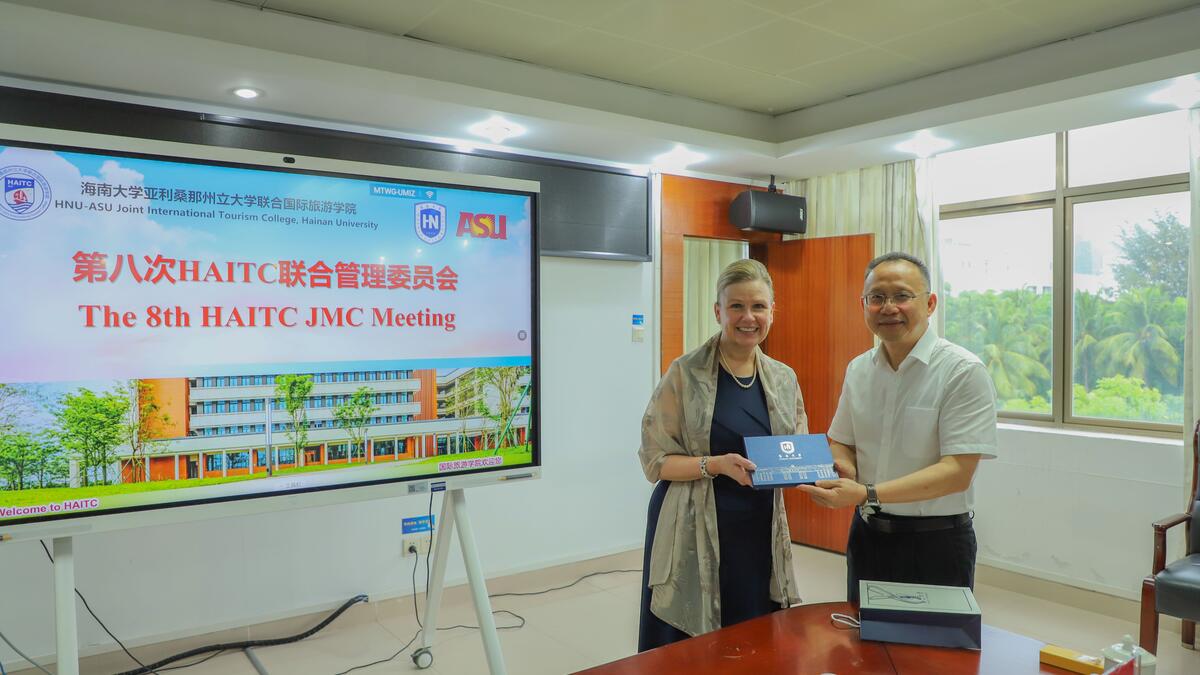
ASU Watts College of Public Service and Community Solutions Dean Cynthia Lietz (left) and Hainan University (HNU) President Qingming Luo share a moment at the 2024 Joint Management Committee meeting at HNU in Haikou, Hainan Province. Photo courtesy Hainan University
The international collaboration between Arizona State University and Hainan University (HNU) in southern China has some milestones to celebrate this year.
The Hainan University–Arizona State University International Tourism College (HAITC) received a prestigious award from the Chinese Ministry of Education as it honored its first cohort of master’s degree recipients in late May. In June, ASU and HNU also agreed to renew their joint administration of HAITC for a new five-year term.
HAITC, which offers degrees in tourism management and parks, recreation and sport management, as well as in public service and public policy, was named among only 20 international joint programs by the Chinese Ministry of Education on its inaugural list of Excellent Cases of Chinese-Foreign Cooperatively-Run Schools.
Kelly Bricker , HAITC director and professor in the School of Community Resources and Development in the Watts College of Public Service and Community Solutions , said the Excellent Cases award is a huge honor for HAITC and ASU. “The word is getting out. It’s the excellence of our program content, supported by a high-quality faculty and staff,” she said.
This year marks the first time the Excellent Cases designation was issued, the ministry said in a statement, “marking a milestone and providing a powerful reference for society to understand Chinese-foreign cooperative education comprehensively and objectively. This groundbreaking evaluation initiative will promote the development of Chinese-foreign cooperative education to a higher and deeper level, injecting new vitality into China's high-level education and opening up to the outside world.”
Bricker said HAITC, established in 2017, is the newest program among the 20 to be recognized. She said the award is an affirmation from the Ministry of Education that HAITC is a high-quality program.
HNU officials were in Tempe on June 13 to join ASU Executive Vice President Chris Howard, chief operating officer of the university’s Academic Enterprise, in signing an agreement pledging to extend the two universities’ relationship for a new five-year term.
The agreement also calls for both institutions to support future academic programs and research development and renew both parties’ commitment to excellence in instruction and program design, said Bricker, who also is a Watts College associate dean.
The universities also agreed to begin developing a program originating in ASU’s Thunderbird School of Global Management. New students would start enrolling in the program in fall 2025.
New master’s degree alumni
Bricker said HAITC students earned master’s degrees for the first time this spring.
The college honored 12 new master’s degree alumni at a May 24 ceremony in China that also celebrated students earning bachelor’s degrees, where Bricker and Watts College Dean and President’s Professor Cynthia Lietz were in attendance. Seven students are receiving Master of Public Administration degrees from ASU this year, while five are receiving Master of Science degrees in tourism management.
HAITC’s spring 2024 cohort of 262 bachelor’s degree recipients is larger than the spring 2023 cohort of 255, according to ASU statistics. Bricker said HAITC’s bachelor’s and master’s degrees will be officially conferred later in June.
This fall, HAITC expects to welcome 30 new master’s degree students, and more than 70% of HAITC’s bachelor’s degree recipients have applied to graduate school, Bricker said. “A very high percentage of them got in.”
“It’s really a true testament to the quality of education our faculty is giving to our students. I’d be remiss if I didn’t recognize the amazing faculty and staff. Without them, none of it would be possible,” Bricker said. “It’s a testament to their dedication to excellence and high quality.”
Credit is also due to the quality of collaboration between the two institutions, Bricker added.
“We have such a dedicated faculty and staff at ASU and HNU, who collaborate to make this work,” she said. “Patience, concern, kindness, inspiration and knowledge peppered with a willingness to be innovative and create something very special with our students is what makes this work. It takes a village, actually two very large villages, dedicated to excellence, to make this happen. We are very fortunate to be a part of this uniquely situated program and partnership.”
Lietz agreed, saying, "It was an absolute pleasure to be able to recognize the graduates of our HAITC program in person this year. I was so impressed by their poster presentations, and celebrating with them on stage was truly an honor. I am grateful for this impactful partnership and cannot wait to return next year to recognize our next group of graduates.”

More Arts, humanities and education
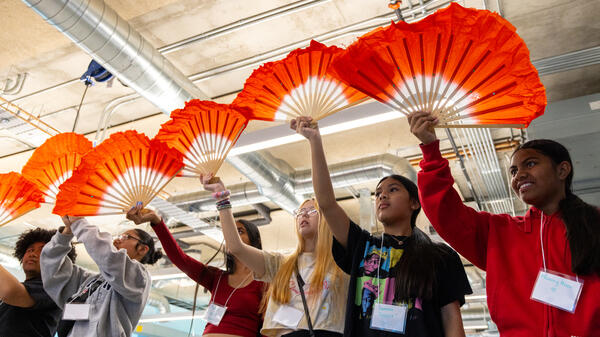
High school students gather at ASU for annual Asian Pacific Advocacy, Culture and Education program
Across the U.S., Asian American, Native Hawaiian and Pacific Islander (AANHPI) communities have a longstanding and rich history of resiliency and contributing to improving society, both locally and…

ASU collaborates with Horizon 2045 to explore a post-nuclear existence in 'Far Futures'
By Bob Beard For nearly a century, nuclear deterrence theory — a paradoxical concept that nuclear weapons somehow make the world safer — has dominated the geopolitical landscape, informing…
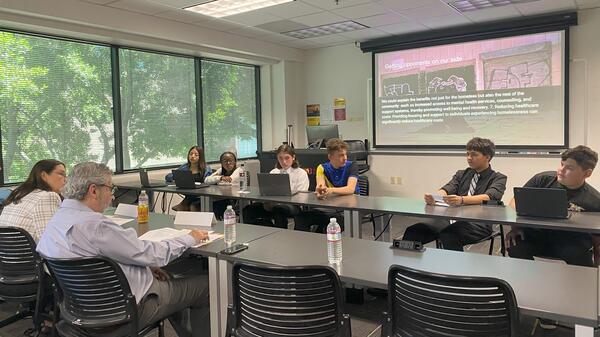
Maryvale students tackle community challenges through public policy lens in statewide showcase at ASU
Local middle school students saw their civics lessons go beyond textbooks as they proposed real policy solutions at a recent competition at Arizona State University. ASU’s School of Public Affairs …
- Share full article
Advertisement
Supported by
Why You’ll Pay More and Behave Better When You Travel This Summer
From Barcelona to Bali, higher fees and new rules are targeting overtourism and unruly behavior. Some locals are worried the changes will keep tourists away.

By Paige McClanahan
A new tourist fee in Bali. Higher hotel taxes in Amsterdam and Paris. Stricter rules on public drinking in Milan and Majorca. Ahead of the summer travel season, leaders in many tourist spots have adopted measures to tame the tourist crowds — or at least earn more revenue from them.
All of this may pose headaches for travelers, although in most cases, the new fees or tax increases represent only a tiny fraction of the total cost of a trip. The goal is to ensure that tourism functions smoothly for visitors and locals alike, said Megan Epler Wood, managing director of the Sustainable Tourism Asset Management Program at Cornell University.
“All tourism is dependent on beautiful natural and cultural resources. You have to protect those resources in order to be a viable tourism destination — and if you don’t, they degrade,” Ms. Epler Wood said.
In some places, proposals for new fees or visitor rules have drawn opposition from residents, who fear they might scare away the tourists who bolster the local economy. But destinations need to find ways to counteract what Ms. Epler Wood calls “ the invisible burden ” of tourism, which includes strains on a community’s infrastructure, utilities and housing stock, as well as tourists’ carbon footprint and any challenges they might impose on residents’ daily lives.
“You put so much pressure on the place that the people who live there become unhappy, and then they don’t present a very good face to tourists,” Ms. Epler Wood said. “The longer you wait, the higher the cost to fix it.”
Here is a look at new measures that travelers can expect this summer, and where others might be coming in the future.
New visitor fees
Since February, visitors to the Indonesian island of Bali have been asked to pay a levy of 150,000 Indonesian rupiahs, or about $9.40 per visit. Revenue will be used to support the preservation of cultural and natural assets on the island, where tourism has brought major challenges related to litter, water supply and overcrowding. Visitors are encouraged to pay the new fee online before departure, although it’s also possible to pay on arrival at the airport.
Beginning Aug. 1, most foreign travelers to the Galápagos Islands — which had a record-breaking 330,000 visitors last year — must pay a $200 entry fee, double the current rate. The money raised will be used to support conservation, improve infrastructure and fund community programs.
The change is the first increase to the entry fee since it was introduced in 1998, said Tom O’Hara, communications manager for the Galápagos Conservation Trust . Mr. O’Hara noted that the increase comes a year after the UNESCO World Heritage Committee urged the government of Ecuador to work toward a “zero-growth model” for tourism in the Galápagos.
“It’s quite a complicated topic,” Mr. O’Hara said, noting that the fee increase has been viewed “as part of the solution to overtourism.” On the other hand, he added, “everyone is trying to reassure the local tourist industry that this isn’t going to kill tourism on the islands.
In April, Venice began imposing a fee — 5 euros, about $5.40 — on day-trippers visiting on peak days, with the goal of striking “a new balance between the tourists and residents.”
But the new Venice Access Fee has drawn criticism from residents. “This project is a disaster for us. We are a city, not a park,” said Matteo Secchi, the president of Venessia.com, an association of Venice residents. Mr. Secchi said that a communications campaign would have been more effective.
The possibility of a new tourist fee has also drawn local opposition in Hawaii, where Gov. Josh Green has proposed a “climate impact fee” for visitors to the state. The measure failed during a recent meeting of the State Legislature, but Governor Green has persisted in calling for visitors to help fund the state’s preparation for future climate shocks.
“We have to get this tiger by the tail,” he told journalists in May, adding that $25 per visitor could raise $250 million a year, which the state could use to guard against climate disasters, manage erosion, strengthen infrastructure and protect parks.
Hotel fees and other taxes get a bump
Hotel taxes, also known as occupancy or accommodation taxes, are widespread in the United States and Europe, where they were on the rise for a decade leading up to the pandemic. With tourism’s rebound to prepandemic levels, several destinations have increased or adjusted the tax to capture more revenue.
Like Hawaii, Greece — which also suffered severe wildfires last summer — is looking to steel itself against climate disasters, and the government wants tourists to help foot the bill. Greece is calling the charge a climate crisis resilience fee , and it will be collected by accommodation providers. The tax will be higher from March to October, when it will top out at €10 per night at five-star hotels. The rate drops from November to February, and for hotels with fewer stars. The fee replaces the previous hotel tax, which ranged from €0.50 to €4 per night.
In Amsterdam, the hotel tax, which was already one of the highest in Europe, rose to 12.5 percent from 7 percent on Jan. 1. City lawmakers have also raised the tax on cruise passengers to €14 from €11 per person per night.
The hotel tax in Barcelona also rose this year, increasing to €3.25 per night. The measure was the final step-up in a gradual increase that began before the pandemic. A spokesman for Barcelona City Hall said that further tax increases would be aimed at tourist rental apartments and cruises that make short stopovers, which contribute less to the city’s income. The spokesman also noted that revenue generated by the tourist tax is being used, among other things, to fund the installation of solar panels and air-conditioning in Barcelona’s public schools.
Ahead of this summer’s Olympic and Paralympic Games in Paris, lawmakers in the Île-de-France region have imposed a new tax, on top of the normal hotel levy. With the new tax, which will fund public transportation in the region, a guest in a five-star hotel now owes a total of €10.73 in tax per night stayed, while a stay in a two-star hotel incurs a tax of €3.25 per night.
Though the measure was adopted by the regional government, it was not supported by the leadership in Paris itself. A spokeswoman for Paris City Hall called the move “a democratic power grab” that “in no way benefits the city of Paris.” She noted that even with the funds generated by the new tax, the region still raised the price of tickets for public transportation in the city during the Olympics — a measure that has disgruntled many Paris residents.
Introducing new rules
In other tourist spots, the focus is on curbing behavior that pollutes the local environment or harms residents’ quality of life.
In Japan, authorities at Mount Fuji will cap visitors at 4,000 per day. They have also imposed a new fee of 2,000 yen (about $13) for access to the iconic summit. Elsewhere in the country, a community council in the Gion neighborhood of Kyoto has closed some small roads to tourists, after complaints that the area, home to the city’s geisha district, was suffering from crowds.
“We will ask tourists to refrain from entering narrow private streets in or after April,” Isokazu Ota, a leading member of the community council, told Agence-France Presse in March. “We don’t want to do this, but we’re desperate.”
A spokeswoman for the city’s tourism board described the road closures as “a local initiative,” adding that “neither Kyoto City nor the Kyoto City Tourism Association are aware of any details beyond what is reported in the media.”
Rowdy visitor behavior has been the target of new rules in Milan. In some areas, city leaders have banned outdoor seating after 12:30 a.m. during the week and 1:30 a.m. on the weekend in response to resident complaints. They have also limited the late-night sale of takeaway food and drinks.
And in certain areas on the Spanish Balearic Islands of Majorca and Ibiza that are overrun with drunk tourists, the government has imposed a ban on late-night sales of alcohol and the consumption of alcohol in the street. New restrictions have also been imposed on party boats in the same areas.
“Tourism has negative externalities that must be managed and minimized,” Marga Prohens, the president of the Balearic Islands, told a local gathering this month , according to The Majorca Daily Bulletin. Local tourism, she said, “cannot continue to grow in volume.”
Paige McClanahan, a regular contributor to the Travel section, is author of “The New Tourist: Waking Up to the Power and Perils of Travel,” forthcoming from Scribner on June 18.
Open Up Your World
Considering a trip, or just some armchair traveling here are some ideas..
52 Places: Why do we travel? For food, culture, adventure, natural beauty? Our 2024 list has all those elements, and more .
Port Antonio, Jamaica: The Grammy-nominated D.J. and music producer Diplo recommends spots in a city he loves on Jamaica’s northeast coast. A dance party makes the cut.
New Mexico: The Gila Wilderness, home to wolves, mountain lions and other wildlife, marks a century as a “land lab,” where nature thrives as far as the eye can see.
Greece: Is Serifos the perfect Greek island? A writer’s checklist included ferry service, great beaches and good local restaurants.
Brooklyn: This 36-hour itinerary skips the most touristy and overdeveloped areas, including Williamsburg and Dumbo, and requires no restaurant reservations or advance planning.
Costa Rica: Travelers are signing up for phone-free tours to try to escape technology’s tether on daily life. But would it make for a better experience ?
/
Algae along the shore of Lake Ohrid, North Macedonia. RooM the Agency / Alamy Stock Photo
In North Macedonia, an Ancient Lake Faces Modern Threats
Lake Ohrid, at 2 million years old, may be the most biodiverse lake of its size in the world, teeming with fish, snails, crustaceans, and more. But tourism development along the edges of the lake and nutrient pollution are clouding its famously clear waters and altering its ecology.
By Richard Mertens • June 18, 2024
On a spring morning, the oldest freshwater lake in Europe lies flat and calm, its wide surface shining. Distant mountains rise in gauzy shades of rose and purple, while water as clear as glass laps against the stony beach. Not far away, a town whose history dates to Greek and Roman antiquity spreads itself along the shore, its white-walled houses gleaming.
Lake Ohrid is almost 2 million years old. Cupped in mountains at the border between North Macedonia and Albania, it is one of fewer than three dozen ancient lakes around the world. These lakes are scattered geological rarities, deep reservoirs of biodiversity, and centers of evolution.
As ancient lakes go, Ohrid is not big — just 19 miles long, nine miles wide and 945 feet deep. But scientists say that, acre for acre, it may be the most diverse lake in the world, teeming with fish, snails, leeches, flatworms, phytoplankton, crustaceans, and more. Of the lake’s roughly 1,200 known native species, 212 of them are endemic, occurring nowhere else.
But Ohrid is also in trouble. It faces growing threats, including from overfishing, nutrient pollution, invasive species, booming tourism, unregulated building, official neglect, and perhaps the most inexorable challenge of all, global warming.
Because ancient lakes contain so many species found nowhere else, once they are degraded, they cannot be fully restored.
Scientists and local activists are worried. Christian Albrecht, a German ecologist at the University of Geissen who has studied the lake, warns of a “creeping biodiversity crisis.” He and other scientists are concerned that if the lake’s problems continue unchecked — problems highlighted in a recent report submitted to the Council of Europe by Andrej Sovinc, a protected areas expert with the International Union for Conservation of Nature — endemic species will decline or disappear. The character of Ohrid as a treasure of biodiversity and a showpiece of evolution, scientists say, could be irreversibly harmed.
“There is of course some resilience,” Albrecht said. “There is fresh water coming all the time from the mountains… The problem is if you have this multitude of pressures, or stressors. At some point every ecosystem will find a tipping point… We really need to be alarmed.”
Ohrid is far from alone. From Tanganyika in East Africa to Baikal in Siberia and Titicaca in South America, the world’s ancient lakes face threats similar to those facing Lake Ohrid. In some places scientists are already seeing a decline in endemic species, including diatoms at the bottom of the food chain in Baikal and the small cichlid fish species that abound in Lake Tanganyika and nearby Lake Malawi.
Lake Ohrid. Robert Atanasovski / AFP via Getty Images
Most of the planet’s lakes are young — less than 10,000 years old — and were formed by glaciation. Ancient lakes, by contrast, were formed by the shifting of mountains, often over millions of years. A smaller number fill the craters of asteroids that hit the earth long ago. A 2018 survey listed 29 ancient lakes around the world, ranging in age from roughly 130,000 years to more than 65 million years.
Ancient lakes have long fascinated scientists for their remarkable biodiversity and the large number of endemic species that evolved — and survived — in these bodies of water over their long existence. Early studies focused on cataloging lake diversity. More recently, scientists have been studying the lakes’ environmental history, hoping to better understand how evolution produced so many species. Using techniques as disparate as DNA analysis and the deep coring of sediments, they have examined the ways in which past changes in climate and local conditions affected both the timing and direction of speciation. One thing is clear: ancient lakes have served both as cradles of new species and as refuges for established species over periods of change.
There’s much that scientists don’t know about ancient lakes. They’re big and deep, and therefore relatively resistant to significant change. But scientists say they’re also vulnerable, in part because the problems they face have been building over decades, including climate change, nutrient pollution, and overfishing. Also, because ancient lakes contain so many species found nowhere else, once they are degraded, they cannot be fully restored.
One study found that visibility in Lake Ohrid had shrunk from a depth of 54 feet in 1920 to 43 feet by 2005.
“If some pieces get lost, it’s something we’ll never get back,” said Catherine O’Reilly, an ecologist at Illinois State University who has studied climate change and its effect on fish populations in Lake Tanganyika. In addition to curbing nutrient pollution and reducing overfishing, scientists have suggested giving greater protection to parts of lakes that are either representative of the whole or exceptionally high in biodiversity.
North Macedonia is one of the poorest countries in Europe, with high unemployment, low wages, and few resources. Tourism has been one of the few ways to boost the economy in recent years. Visitors come for Ohrid’s beauty, but also because it’s relatively affordable.
To accommodate and attract these visitors, new hotels, apartments, and restaurants have been built, and are still being built, near the lake, despite a ban on new construction within 50 meters of the shore. The new buildings, together with new marinas and an increase in boat traffic, have destroyed or harmed habitat, including marshlands and reed beds, in many areas.
Pollution has also increased from poorly functioning municipal treatment systems — and sometimes from sewage lines emptying directly into the water — and from agricultural pollution in the watershed. Nutrients from both sources are causing algae to accumulate on rocky lake bottoms near populated areas, turning clear water cloudy and degrading shallow-water habitat for native species. Studies in nearshore areas have also found a shift from diatoms and invertebrates that thrive in a low-nutrient environment toward species that thrive in a nutrient-rich environment.
A fisher releases young Ohrid trout back into the Albanian portion of Lake Ohrid last November. Adnan Beci / AFP via Getty Images
Lake Ohrid and other cold-water ancient lakes are oligotrophic, or low in nutrients, which explains their remarkable clarity. Oligotrophic lakes are also rich in oxygen — and life — all the way to the bottom. But over decades, the clarity of Ohrid’s water has declined. One study found that visibility had shrunk from a depth of 54 feet in 1920 to 43 feet by 2005. Scientists have noticed changes in species composition in the deepest water, including deep water algal blooms and an increase in minnows that feed on that algae. The range of some mussels has shrunk. Some snails have become rare.
The most famous species in Ohrid is the Ohrid trout. It’s endemic to the lake and has long graced local dinner tables. But overfishing has so reduced its numbers that catching it is now illegal on the Macedonian side, though people say poaching is common. At the same time, the Ohrid trout faces new competition from seven introduced species of fish, including rainbow trout. Other invasive species have found their way into the lake, including two new snail species, though these have yet to displace any of the natives. More worrisome may be the proximity of zebra and quagga mussels, native to the Black Sea, which have wrought so much ecological damage in the Great Lakes, in North America. They could easily reach Lake Ohrid attached to a boat, in the water of a bait bucket, or on some bit of gear.
“To me it’s just a matter of time,” Albrecht said. “And what happens when they meet the native mussels?”
Some people are afraid to criticize government inaction for fear of getting in trouble with local authorities, says a conservationist.
Gastropods, a classification that contains snails and slugs, are one of the most diverse groups in the lake. Scientists have discovered 68 species of snails, three quarters of them endemic. But for these tiny organisms, even small changes — such as algae colonizing rocks — can have big effects, Albrecht said. “Where you had a meadow of aquatic grasses, all of a sudden you find yourself in an algae forest. These changes are drastic and can definitely lead to the disappearance and local decline of these animals.”
Climate change poses a bigger challenge. Scientists fear that rising surface temperatures will lead to greater stratification of the water column and less mixing. This could deprive the deeper water of oxygen, imperiling the many endemic species that live there. Nutrient pollution, especially phosphorous from sewage, heightens this effect by further reducing oxygen levels. Researchers have estimated that if temperatures rise as predicted by the end of the century, the phosphorus in Ohrid would need to be cut in half to keep its depths from becoming so low in oxygen that deep water creatures will not survive.
Ohrid is not without its defenders. The local conservation movement is small but passionate, its members few but deeply attached to the lake. Nikola Paskali is one of them. A diver, archeological enthusiast, and conservationist, he has spent years exploring the lake. He recently made a series of videos for schoolchildren, sponsored by the United Nations, to call attention to its problems.
Conservationist Nikola Paskali. Richard Mertens
But arousing concern for the lake is hard in a country as poor as North Macedonia, he said. “When we fix social problems, afterward it’s possible to fix the ecological problems with the lake.”
Among the most determined activists are members of Ohrid SOS, a small group that has labored to bring the lake’s problems — including illegal construction and the degradation of the lake’s last intact wetland — to the attention of a wider public. But political action is risky, said Katerina Vasileska, a local tour guide and SOS member. She said some people are becoming more interested in the environment and in her group’s work, but they are afraid to speak out or to criticize government inaction for fear of getting in trouble with local authorities or losing their jobs. (The Ohrid Municipality declined to make anyone available to comment.)
“People are aware a lot more,” Vasileska said. “But they are not willing to fight. They are kind of passive.”
Dusica Ilek-Boeva, a biologist at the PSI Hydrobiological Institute Ohrid, a research center founded at the lake in 1935, is more hopeful. She’s also a teacher, and on a recent spring day she introduced a group of ninth graders from the capital, Skopje, three hours away, to the Lake Ohrid ecosystem. While she explained food chains using a computer diagram, the students poked at samples of sediment from a nearby spring and other areas connected to the lake, plucking out with tweezers the tiny squirming creatures that contribute to Ohrid’s enormous biodiversity.
Ilek-Boeva was pleased. She thinks the next generation will do better. “If this lake has been here for 2 million years,” she said to the students, “I hope it will survive us.”
Related Articles
As ‘zombie’ deer disease spreads, scientists look for answers.
By Jim Robbins
Despite Criticism, the Last of the Rattlesnake Roundups Hang On
By Ted Williams
Tracking Illicit Brazilian Beef from the Amazon to Your Burger
More from e360, biodiversity, how a ‘citizen map’ is helping brazil prepare for next big flood, a key court ruling could weaken u.s. environmental protections, pollution paradox: how cleaning up smog drives ocean warming, can a california oilfield be retrofitted to store solar energy, how an el niño-driven drought brought hunger to southern africa, in seawater, researchers see an untapped bounty of critical metals, in a dammed and diked mekong, a push to restore the flow, how one south african community stopped shell oil in its tracks.

IMAGES
VIDEO
COMMENTS
By pope86. This sign as written is located on the river bank and is a great place for photos and going for a stroll with friends... 7. Perm Academic Theatre-Theatre. 67. Architectural Buildings. Perm Academic Theatre-Theatre is one of the oldest theatres of Perm region, as it was founded on the 14th of March 1927.
67. Architectural Buildings. Perm Academic Theatre-Theatre is one of the oldest theatres of Perm region, as it was founded on the 14th of March 1927. Almost a century of its history shows a story of a remarkable development: …. 7. Motovilikhinskiy Plant History Museum. 130. History Museums. By alexey2612.
Texas A & M University-College Station offers 7 Travel and Tourism degree programs. It's a very large, public, four-year university in a midsize city. In 2022, 293 Travel and Tourism students graduated with students earning 151 Certificates, 122 Bachelor's degrees, 14 Master's degrees, and 6 Doctoral degrees. Based on 23 Reviews.
617760-617766, 617769. Dialing code (s) +7 34241. OKTMO ID. 57654101001. Website. chaikovskiyregion .ru. Chaykovsky ( Russian: Чайковский) is a town in Perm Krai, Russia, located on the Kama River 325 kilometers (202 mi) southwest of Perm, the administrative center of the krai. Population: 86,714 ( 2002 Census ); [8] 85,849 ( 1989 ...
Arizona State University Campus Immersion offers 2 Tourism and Travel Services Management degree programs. It's a very large, public, four-year university in a midsize city. In 2022, 53 Tourism and Travel Services Management students graduated with students earning 40 Bachelor's degrees, and 13 Certificates. Based on 38 Reviews.
The Tourism School, an institution scripts a foundation of a great revolution in the field of Tourism Studies as vocation oriented courses. The institute aspires to provide knowledge to produce ...
Usva River. 16. Bodies of Water. Kolpaki Mountain. 8. Mountains. Frequently Asked Questions about Perm Krai. What is Perm Krai known for? Perm Krai Tourism: Tripadvisor has 23,951 reviews of Perm Krai Hotels, Attractions, and Restaurants making it your best Perm Krai resource.
Hospitality management online degree programs vary widely across the universities and colleges. Tourism and hospitality degree programs offer bachelor and master degrees in many different concentrations and specializations, such as tourism, hospitality, travel, recreation, and event/meeting management.
Perm is located in the east of the European part of Russia, on the Kama River that flows from the Urals. It is the capital of Perm Krai, and the industrial, scientific, and cultural centre of the Urals. This is the third largest Russian city (by area). Perm is more than 1,400 km away from Moscow. Perm is well-known for its ancient history ...
Downloadable! Located in the south of Ural, Perm Krai, apart from mineral resources and well-developed industry, can boast vast areas that lend themselves to active and qualified tourism, with the quality of an amateur sport. The development of these forms of tourism often requires large expenditure needed for adjusting the space to various types of activity.
Perm Krai (Russian: Пе́рмский край, romanized: Permsky kray, IPA: [ˈpʲɛrmskʲɪj ˈkraj]; Komi-Permyak: Перем ладор, romanized: Perem lador) is a federal subject of Russia (a krai), located in Eastern Europe.Its administrative center is Perm.The population of the krai was 2,532,405 (2021 Census).The krai was formed on 1 December 2005 as a result of the 2004 referendum ...
e-ISSN 2080-6922 ISSN 0867-5856 Tourism 2016, 26/1 DOI: 10.1515/tour-2016-0007 Aleksander I. Ziryanov Andriej Y. Korolev Swietlana E. Mishlavtceva
A member program of the National Academy Foundation (NAF), the Academy of Travel & Tourism operates as a "school within a school" and is located in more than 159 high schools nationwide. Travel and tourism has generally shown itself to be recession-resistant: even in downward business cycles, the industry has grown.
Top schools offering Travel and Tourism degrees in California. Travel and Tourism. Tourism and Travel Services Marketing Operations Schools; List of all Travel and Tourism colleges in California. School Average Tuition Student Teacher Ratio Enrolled Students; Los Medanos College Pittsburg, CA: 1/5:
Regions []. Permyakia — a large, but sparsely populated region in the northwest of Perm Krai, where ethnic Komi-Permyaks constitute a majority; Cities []. Perm — the capital is a major industrial city with nearly one million residents; Berezniki — the second largest city in the region is a mid-sized industrial Stalinist monster; Cherdyn — this village is purportedly the capital of the ...
California State University Northridge. USA. English courses available. View 1 Travel and Tourism courses. 26019. Views. 455. Favourites. Review (1)
Perm is the most Eastern city of Europe, and therefore its province is often referred to as Eurasia. Having a population of 1 million, Perm' is one of the largest cities in Russia and the second largest in the Urals. The city was formerly called Molotov, after the minister of foreign affairs during Joseph Stalin's ruling.
Landmarks and tourism. The Perm Territory is a major cultural centre. There are many theatres, museums, numerous festivals. ... (120 km from Perm). It is a fairy-tale place at the foot of Arinina Mountain. The park has kids' skiing school of the Olympic reserve. Molebskaya anomaly zone, the locals call it Molebka (170 km from Perm). It is a ...
The Tourism Academy's mission is to educate, empower and inspire the tourism industry. Subsequently, making it easier for travel professionals to advance their careers, grow their businesses and provide life-changing travel experiences to more people, sustainably. The Tourism Academy is a registered 501 (c) (3) nonprofit organization.
The article deals with the new system principles of planning for tourism development and inclusion of new areas in the tourist system in a region, based on the cluster-dominant approach using geographical methods. We describe a technique of spatial analysis and planning of tourism. From the geographical perspective, we analyze the concept of "tourist cluster": the genesis of clusters ...
Perm-36. 58°15′47.2″N 57°25′55.6″E / 58.263111°N 57.432111°E Main building Reconstruction of one of the prisoner barracks The fence at Perm-36 Perm-36 was a Soviet forced labor colony located near the village of Kuchino, 100 km northeast of the city of Perm in Russia. Map.
The travel and tourism sector's potential for advancing socio-economic prosperity is particularly impactful through the support of micro-, small-, and medium-sized enterprises. The global travel sector forecast is in and it's sunny skies ahead. Through March 2024, consumer spending on travel remains strong, and passenger traffic has soared.
It isn't just Swift who is driving business for "tour tourism" - last year saw U.S. fans flocking to Europe for Beyonce's "Renaissance Tour," and unexpected cities on Expedia's list of top tour ...
Boston — Today, Governor Maura Healey announced a new tourism campaign called "Made Possible" to showcase Massachusetts as a dynamic travel destination for visitors across the globe and the best place to live, raise a family, and build a business. The campaign builds off of the administration's "Massachusetts For Us All" campaign, which ran in the Summer of 2023, as well as proposed ...
Stay. A mix of the charming, modern, and tried and true. See all. Four Elements Hotels Perm. 592. from $57/night. Ural. 504. from $43/night.
Studying a Certificate II in Tourism (SIT20122) through TAFE at School, Lucia graduated at 17 and began working in the industry almost immediately at the boutique hotel, The Inchcolm. "Working at The Inchcolm gave me vital experience across the various areas, undertaking tasks required to operate a hotel successfully," she said.
The international collaboration between Arizona State University and Hainan University (HNU) in southern China has some milestones to celebrate this year. The Hainan University-Arizona State University International Tourism College (HAITC) received a prestigious award from the Chinese Ministry of Education as it honored its first cohort of master's degree recipients in late May.
June 4, 2024. A new tourist fee in Bali. Higher hotel taxes in Amsterdam and Paris. Stricter rules on public drinking in Milan and Majorca. Ahead of the summer travel season, leaders in many ...
In North Macedonia, an Ancient Lake Faces Modern Threats. Lake Ohrid, at 2 million years old, may be the most biodiverse lake of its size in the world, teeming with fish, snails, crustaceans, and more. But tourism development along the edges of the lake and nutrient pollution are clouding its famously clear waters and altering its ecology.
This document explains how community schools partner with community organizations to provide: 1) integrated student supports, 2) expanded and enriched learning time and opportunities; 3) active family and community engagement; and 4) collaborative leadership and practices. Because community schools respond to the specific needs of the community ...